Rich swirls of emerald, mint, and jade are stealing the spotlight in 2025 kitchens and baths, turning the once-traditional marble counter into a vibrant statement surface. Designers praise green marble’s wide shade range—from shadowy forest tones to airy pastels—and its compatibility with trending finishes like honed or leathered textures. Waterfall edges, integrated sinks, and dramatic book-matched slabs let the stone’s veining read like abstract art, while warm metals and natural oak keep the look inviting. Homeowners gain the glow of authentic stone with practical tips—sealed surfaces, smart lighting, and thoughtful pairings—that ensure these countertops remain the room’s crowning jewel for years to come. Natural Stone City
1. Deep-Emerald Island as Functional Art
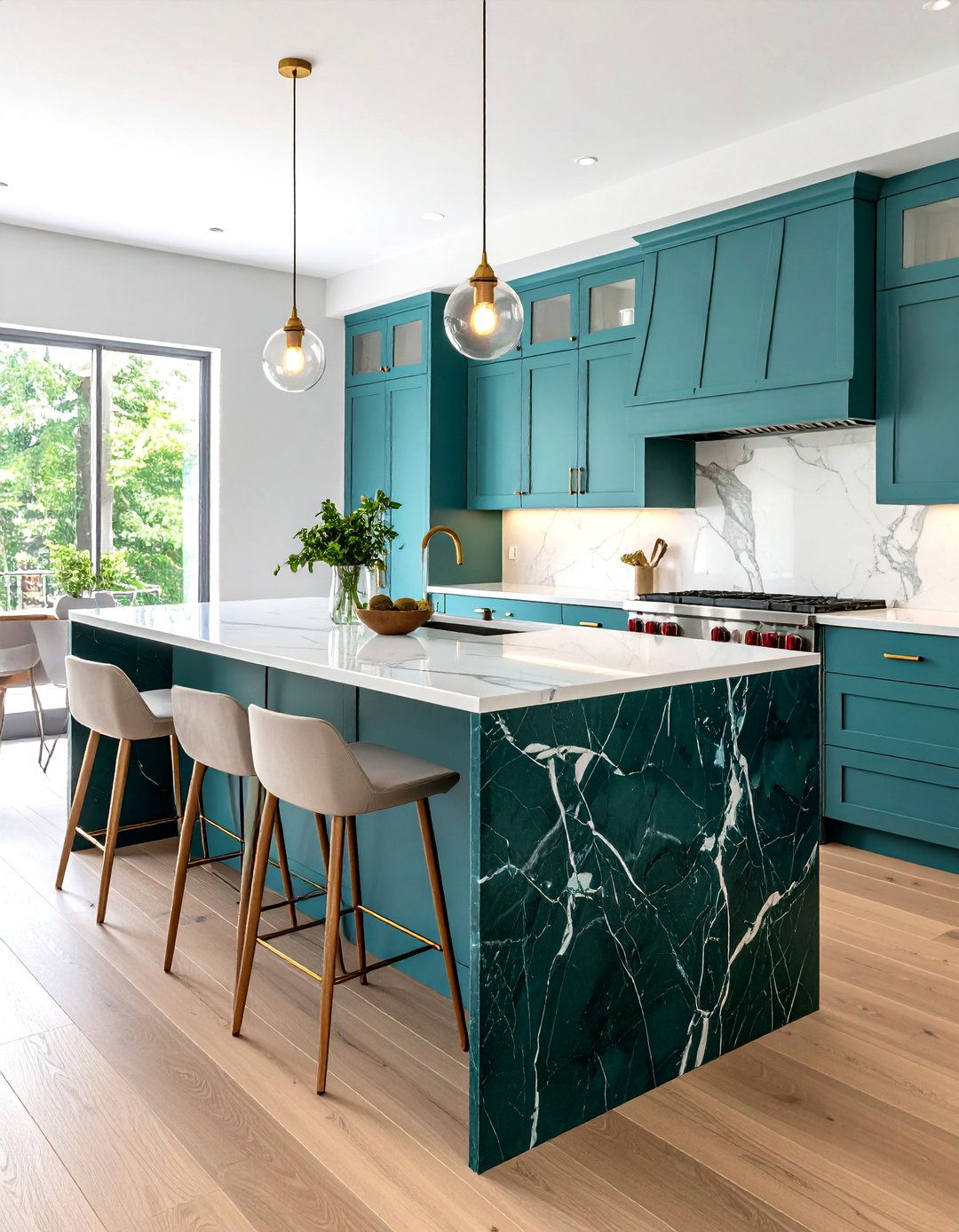
A broad green marble countertop island instantly anchors an open kitchen, acting as both prep zone and sculptural centerpiece. Pick a slab such as Empress Green or Verde Alpi for its pronounced white veining, then frame it with clean, handle-less cabinets so the stone can shine. Designers note that dramatic veining is a top request in 2025 because it turns a practical surface into visual art, especially if you allow the veins to “waterfall” down the sides. Balance that intensity with matte hardware and muted flooring; the contrast lets the marble’s color pop without overwhelming the space. Always seal thoroughly and wipe spills fast to preserve the vivid hue. Better Marble Homes & Gardens The Washington Post
2. Forest-Green Waterfall Edge Monolith
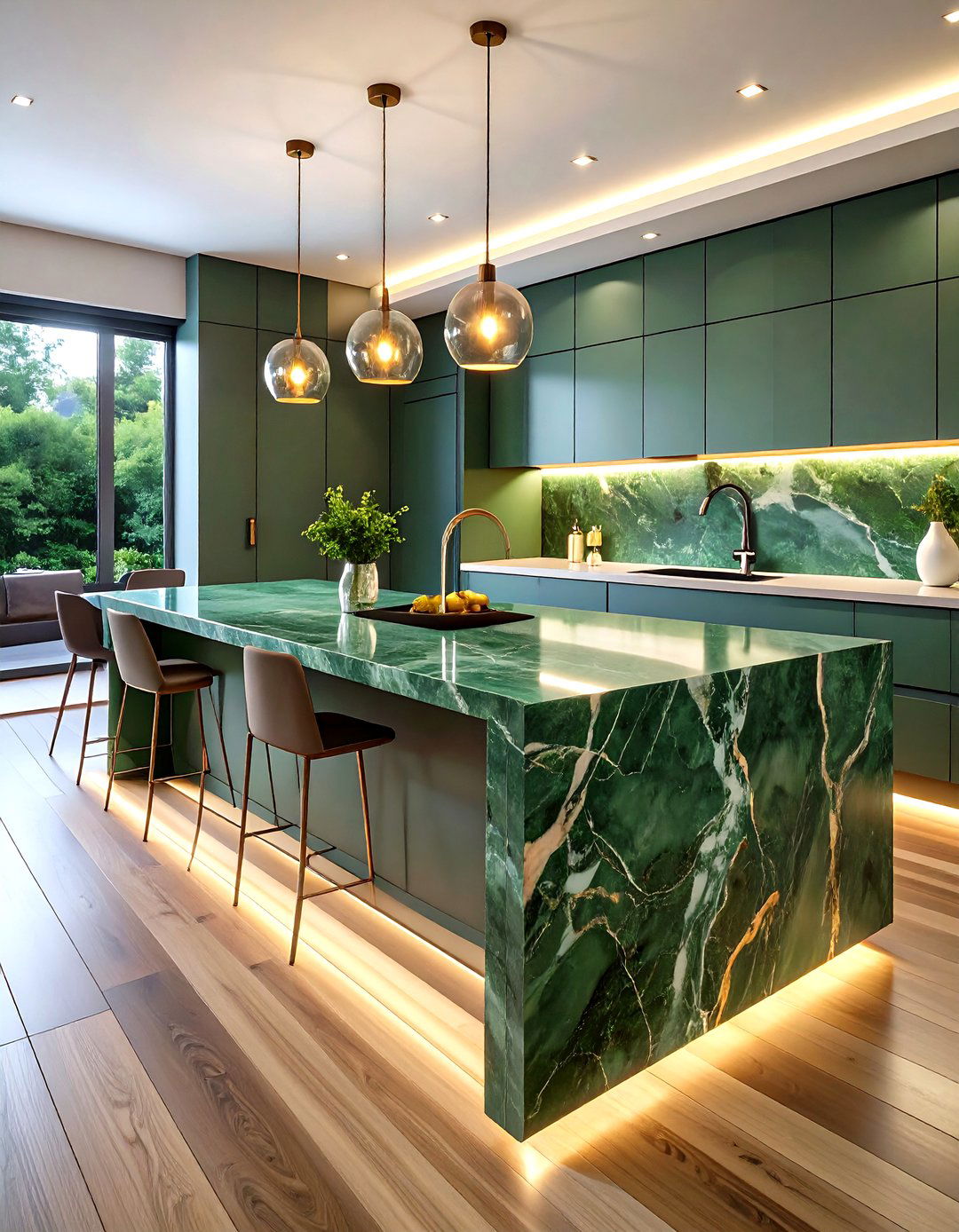
For an ultra-modern vibe, run the same forest-green marble over the counter and down both gable ends, creating a sleek waterfall edge that displays every vein uninterrupted. Stone suppliers confirm waterfall profiles are soaring in popularity because they spotlight luxurious materials while protecting cabinetry corners. The uninterrupted flow of a Verde Guatemala slab offers mesmerizing depth, and when paired with slimline toe-kicks the island almost appears carved from a single boulder. Undercabinet LEDs grazing the stone will amplify shadow and highlight, emphasizing texture after dusk. Remember to request reinforced miter joints at fabrication—marble is brittle at 90-degree seams—so the slab looks seamless and stays sturdy. Natural Stone City Pinterest Cornerstone House
3. Veined Verde Alpi and Brushed-Brass Glam
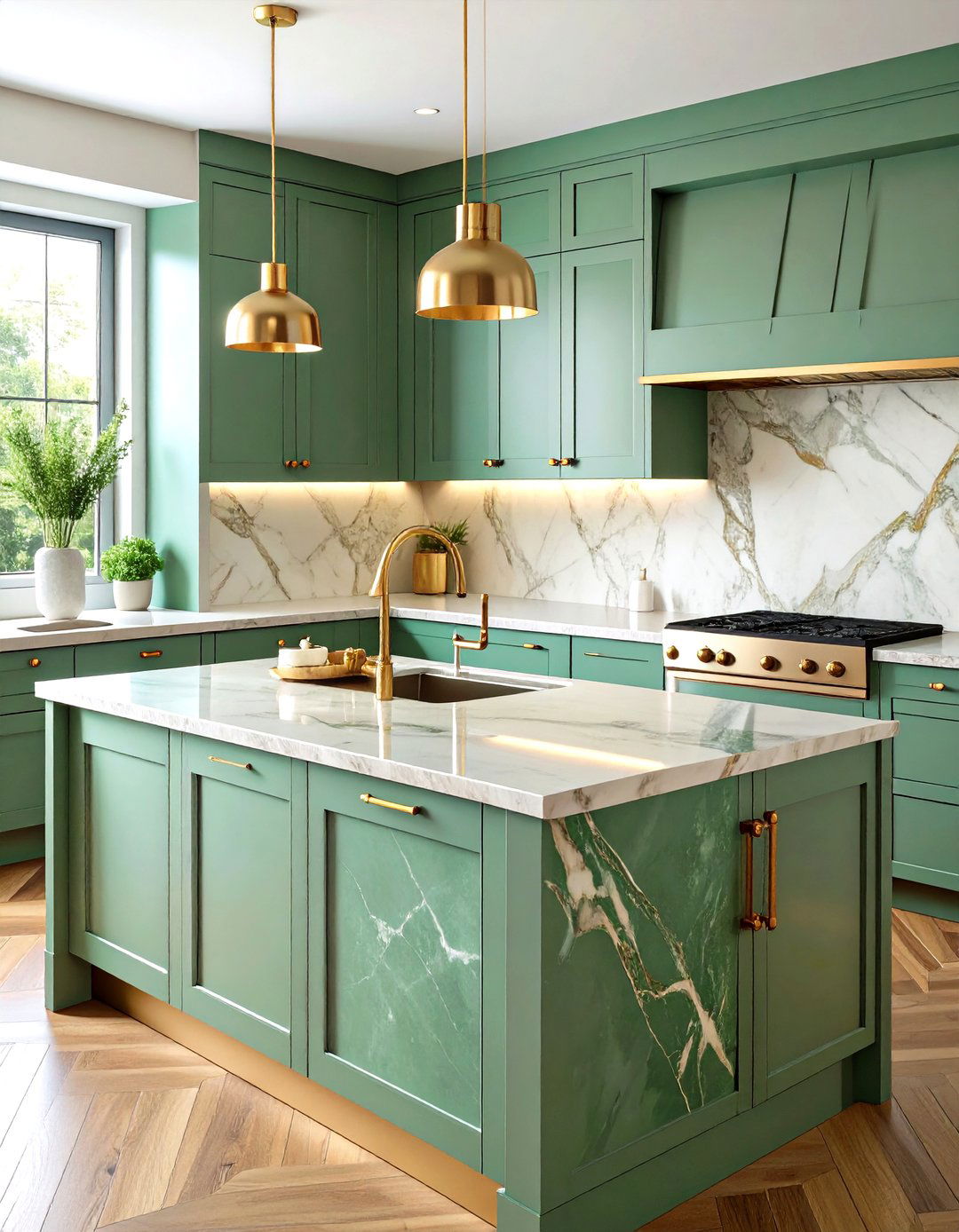
Unlike cooler whites, a green marble countertop welcomes warm metallics. Designers are pairing richly veined Verde Alpi with brushed-brass pulls and faucets for a sophisticated, jewelry-box effect. Brass’s golden undertone pulls subtle amber streaks from the stone, making the countertop glow even in low-light kitchens. Color experts say moody greens offset brass beautifully, preventing it from reading garish. To avoid visual clutter, keep hardware shapes simple—slim T-bars or edge pulls—and repeat the metal on lighting or bar-stool frames. Finish the marble with a soft polish so reflections stay refined, not mirror-bright, letting veins stay the star while brass adds a whisper of luxe accent. Better Marble Ideal Home
4. Mint-Green Marble in a Honed Finish
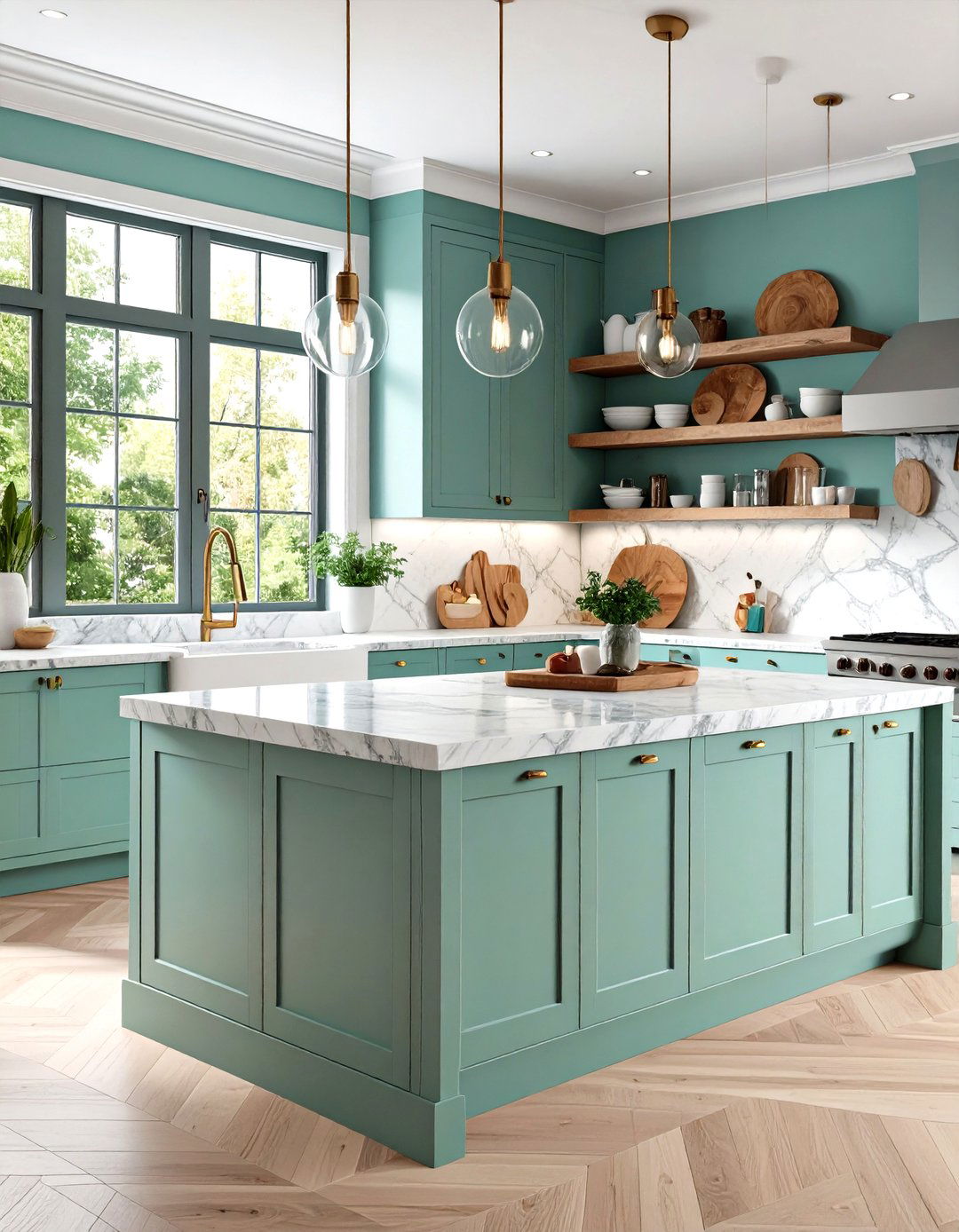
Honed surfaces—matte, velvety, gently light-absorbing—are a 2025 favorite because they hide fingerprints and soften bold color. A mint-green marble countertop in a honed finish gives Scandinavian serenity to compact kitchens, pairing especially well with white oak shelves. Stone experts note honed marble resists scratches better than high-gloss yet does need prompt spill cleanup to prevent staining, so keep neutral pH cleaner handy. Top the slab with chunky wood boards and ribbed glass jars for tactile contrast. If you crave subtle sheen, choose a “satin” hone, which falls between full matte and polish, delivering practicality without sacrificing the stone’s luminous depth. Cutting Edge Countertops
5. Book-Matched Rainforest-Green Slab Feature
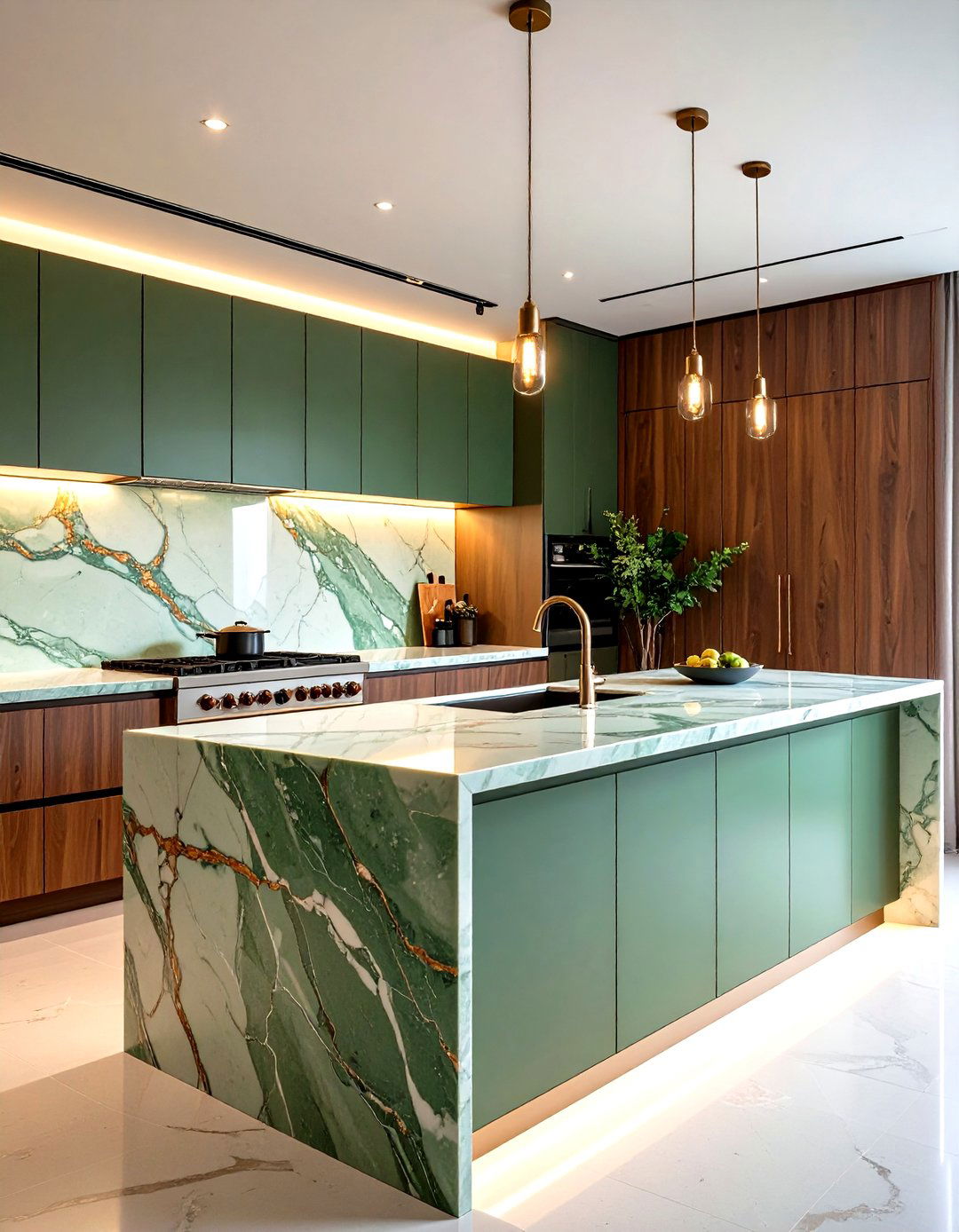
For jaw-dropping drama, ask your fabricator to slice a Rainforest Green block and mirror the halves along the countertop and backsplash. Book-matching turns the caramel and ivory veins into symmetrical patterns reminiscent of tree branches—perfect for biophilic interiors. Home projects showcased this year reveal designers placing LED strips beneath upper cabinets, so the mirrored veining casts a subtle forest-canopy effect at night. Precision layout is crucial: photograph each slab face before cutting and digitally mock-up the matchup to avoid surprises. Seal with a high-penetration sealer; the stone’s iron content can rust if moisture penetrates. The payoff is a one-of-a-kind living artwork behind your sink. Pinterest Stone Contact Homes & Gardens
6. Moody Black Cabinets with Green Marble Tops
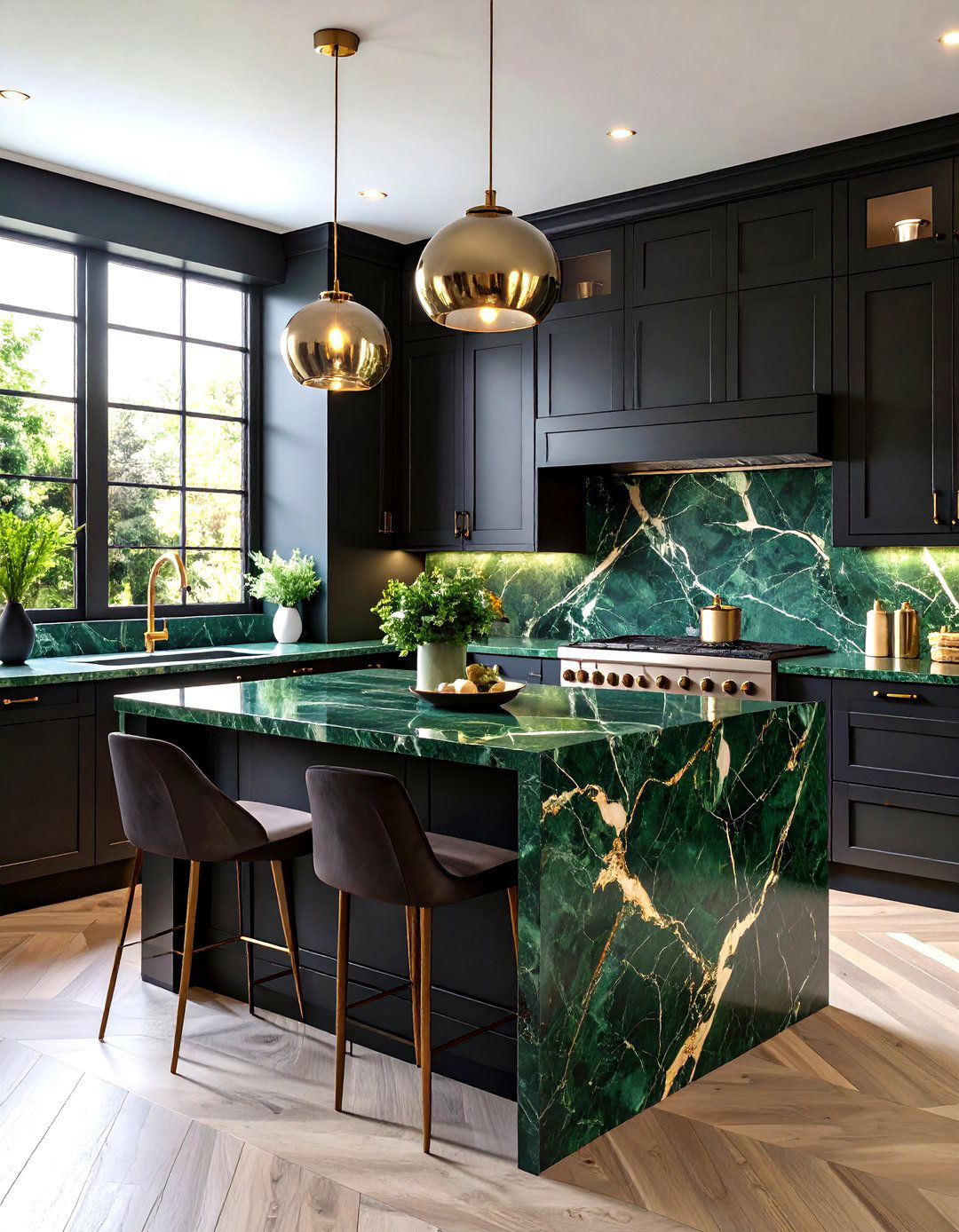
Consider the striking tension created when deep-green marble meets jet-black cabinetry. Houzz galleries show this palette delivering boutique-hotel sophistication while hiding everyday scuffs on cabinet doors. Choose a marble displaying lighter quartz veins to keep the scheme from plunging into darkness, and add matte-brass sconces for a hint of warmth. Maintenance experts warn that dark cabinets accentuate hard-water marks on the countertop edge, so wipe sinks and drips quickly. The overall effect is cocoon-like luxury—perfect for open-concept apartments that double as evening entertaining spaces, where a dramatic backdrop sets off metallic barware and moody pendant lighting. Houzz Homes & Gardens
7. Reclaimed-Slab Mosaic Inlay Accent
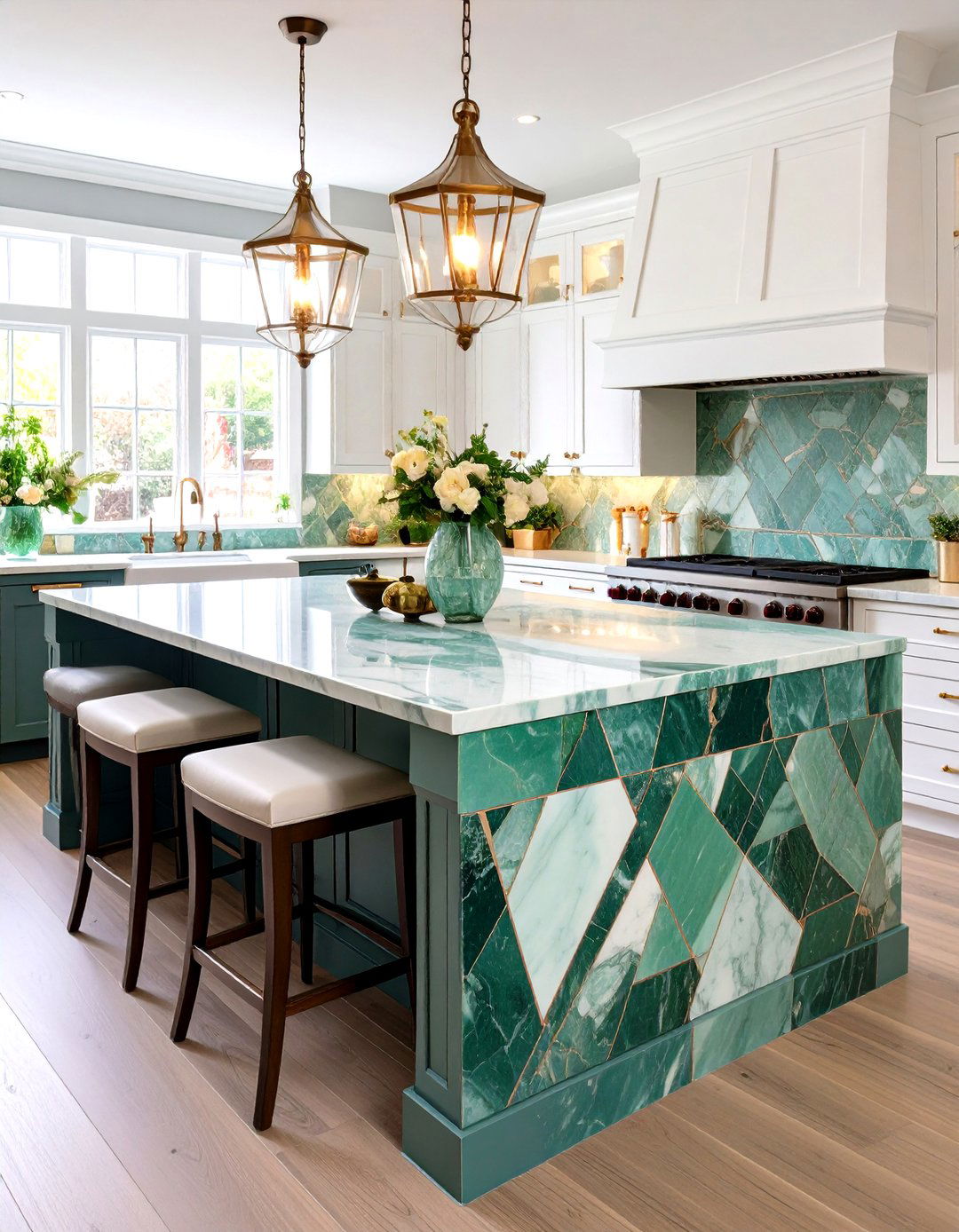
Sustainability drives many remodels, and reclaimed green marble countertop offcuts can be transformed into a show-stopping mosaic inlay. Fabricators often have remnants from luxury builds—ask for contrasting pieces like Empress, Ming, and Verde Tinos, then cut them into geometric tiles for an island accent strip or pastry station. Besides reducing waste, mixing tones gives a curated, artisan feel reminiscent of historic terrazzo. Seal individual pieces before grouting to prevent pigment bleed, and choose a neutral epoxy grout for easier cleaning. Designers say this patchwork technique offers budget-friendly access to premium stone, turning small fragments into a richly patterned, eco-chic surface. Homes & Gardens Creative Granite & Design
8. Warm Oak Pairing for Organic Balance
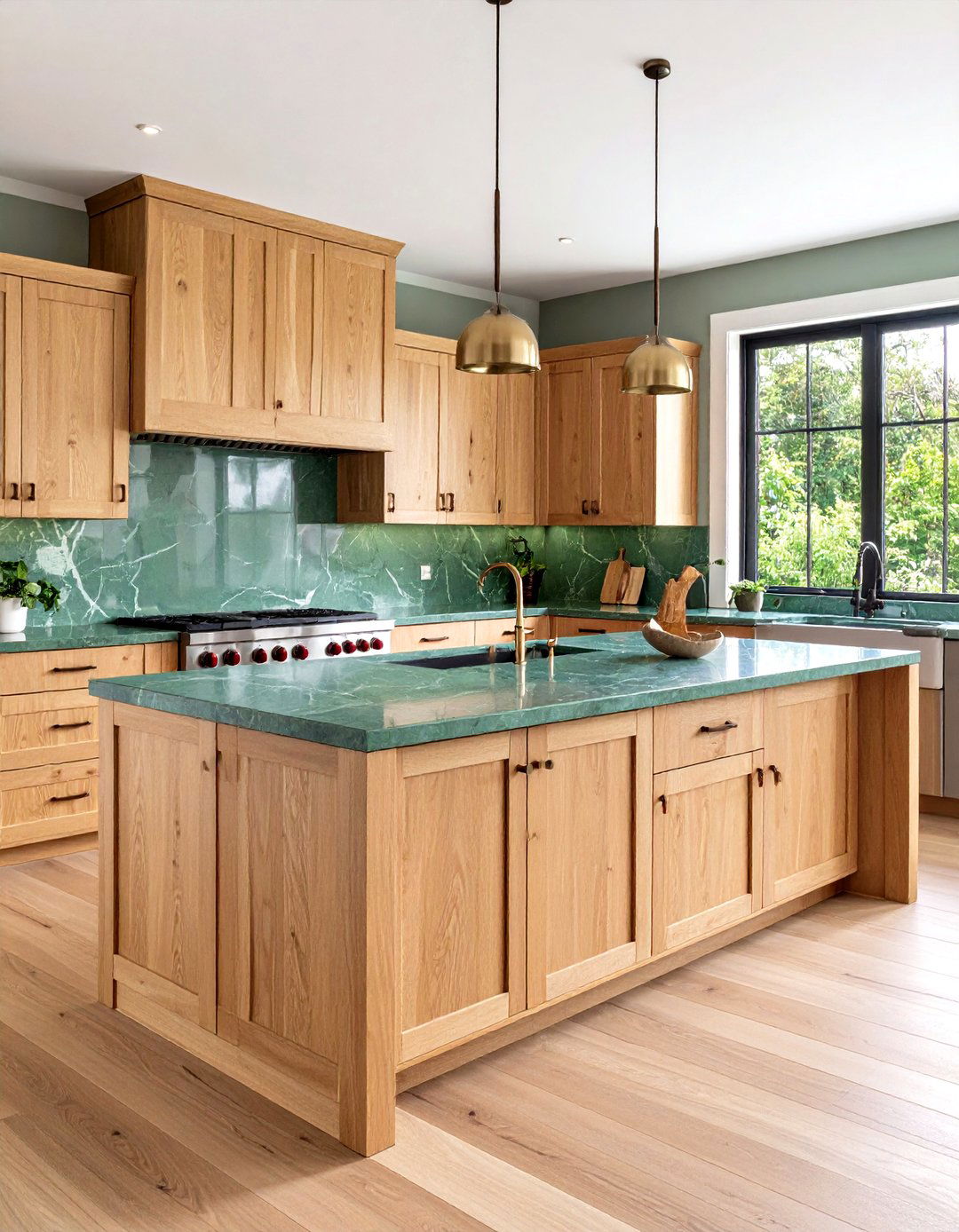
Bringing natural timber beside a green marble countertop softens the stone’s cool undertone and echoes forest palettes outdoors. Interior pros highlight quarter-sawn white oak or rift-cut walnut as ideal companions—the tight grain and honeyed hue introduce warmth without busy patterns. Opt for slab-front drawers so the marble’s veining remains focal. A food-safe oil finish on the wood keeps maintenance simple and contrasts nicely with the sealed stone. Layer open shelving with ceramic planters to pick up olive flecks in the marble. The result feels calm, organic, and timeless, bridging modern minimalism and rustic charm in equal measure. Ideal Home
9. Vintage Green Marble Console Repurposed
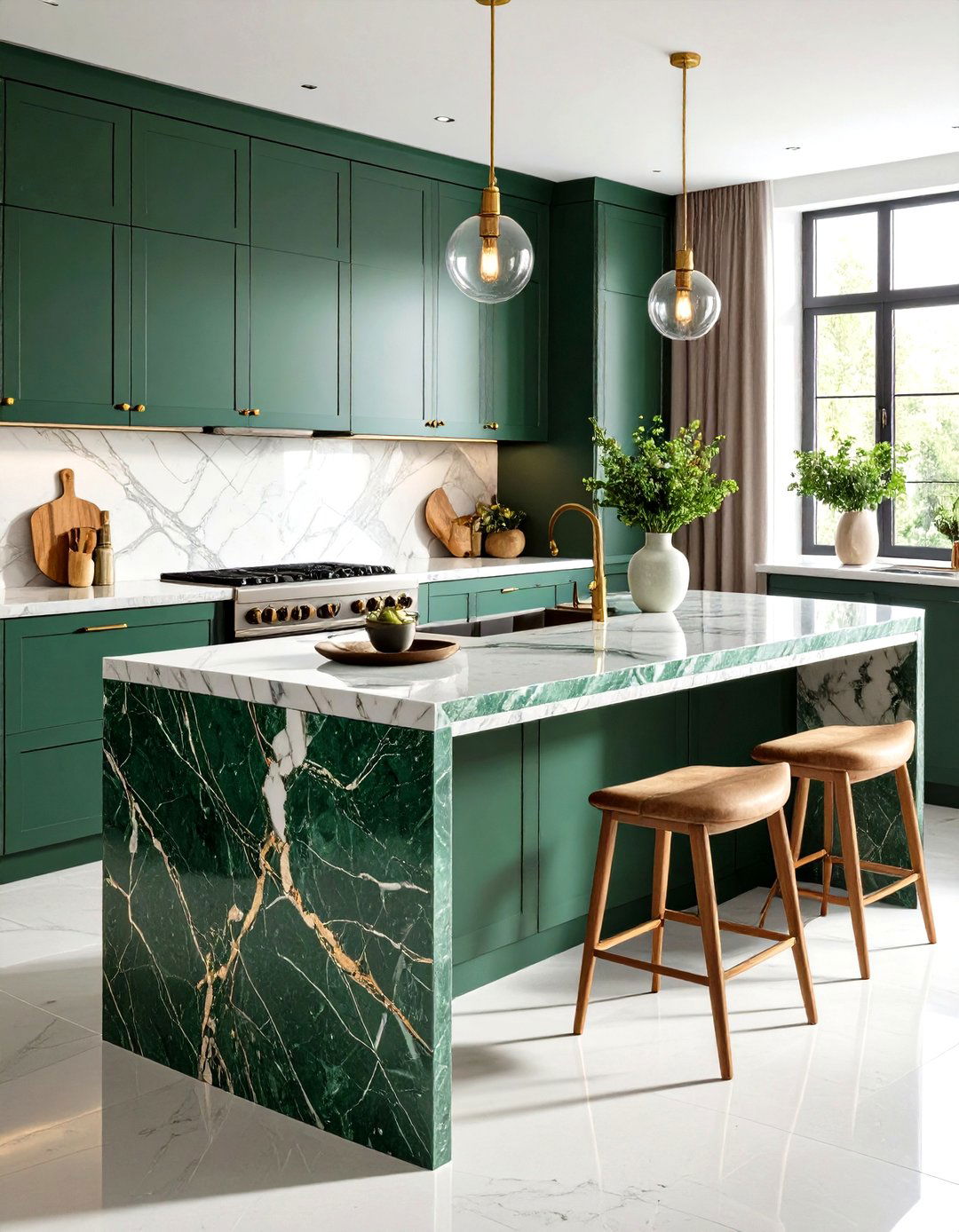
Salvage yards are treasure troves of thick, antique green marble slabs once adorning bank counters or hotel lobbies. Re-cutting these into a kitchen pass-through or hall console offers character impossible to replicate with new stone. Designers suggest leaving minor fissures and patina intact—they narrate the slab’s history and align with 2025’s appreciation for texture. Strengthen older marble by laminating a concealed plywood substrate before installation. While repurposed stone may have etch marks, a honed refinish will unify the surface without erasing charm. You’ll gain a sustainable statement piece while side-stepping the carbon footprint of quarrying fresh blocks. Homes & Gardens The Washington Post
10. Serpentine Green Marble for Alfresco Kitchens
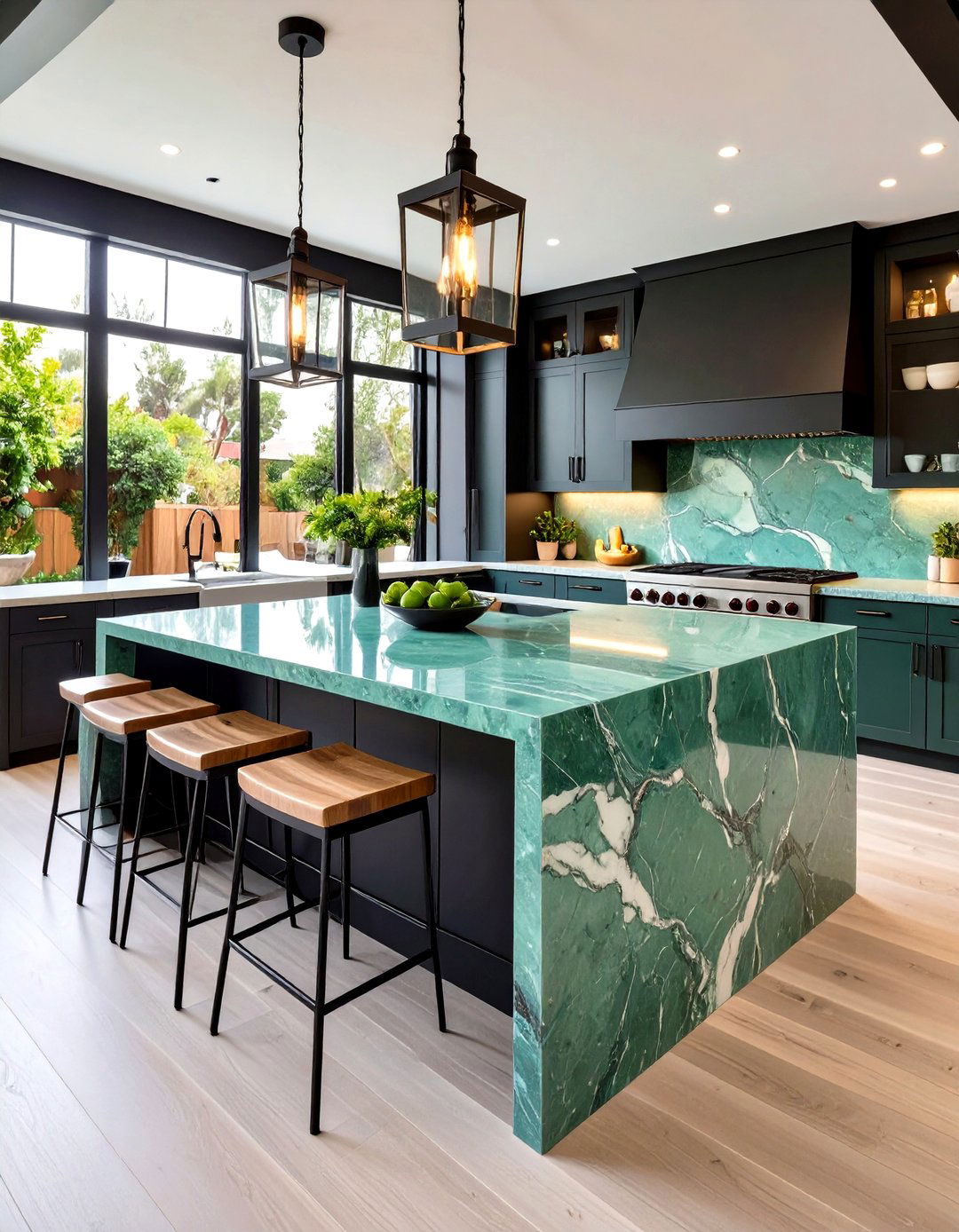
Homeowners seeking outdoor pizza islands or poolside bars can choose green serpentine—often sold as “green marble”—for superior acid and scratch resistance versus true marble. Fabricators note serpentine’s denser structure shrugs off citrus spills and chlorinated splash-back, crucial in alfresco settings. Anchor a thick-edged slab atop powder-coated steel frames and finish with UV-stable penetrating sealer to protect against sun fade. Pair with weathered teak stools and matte-black fixtures for coastal-luxe appeal. In colder climates, specify thermal breaks between stone and metal supports to prevent freeze-thaw cracking. A durable, nature-inspired counter transforms outdoor cooking into a sophisticated, low-maintenance affair.
11. Ultra-Thin Profile, Maximum Impact
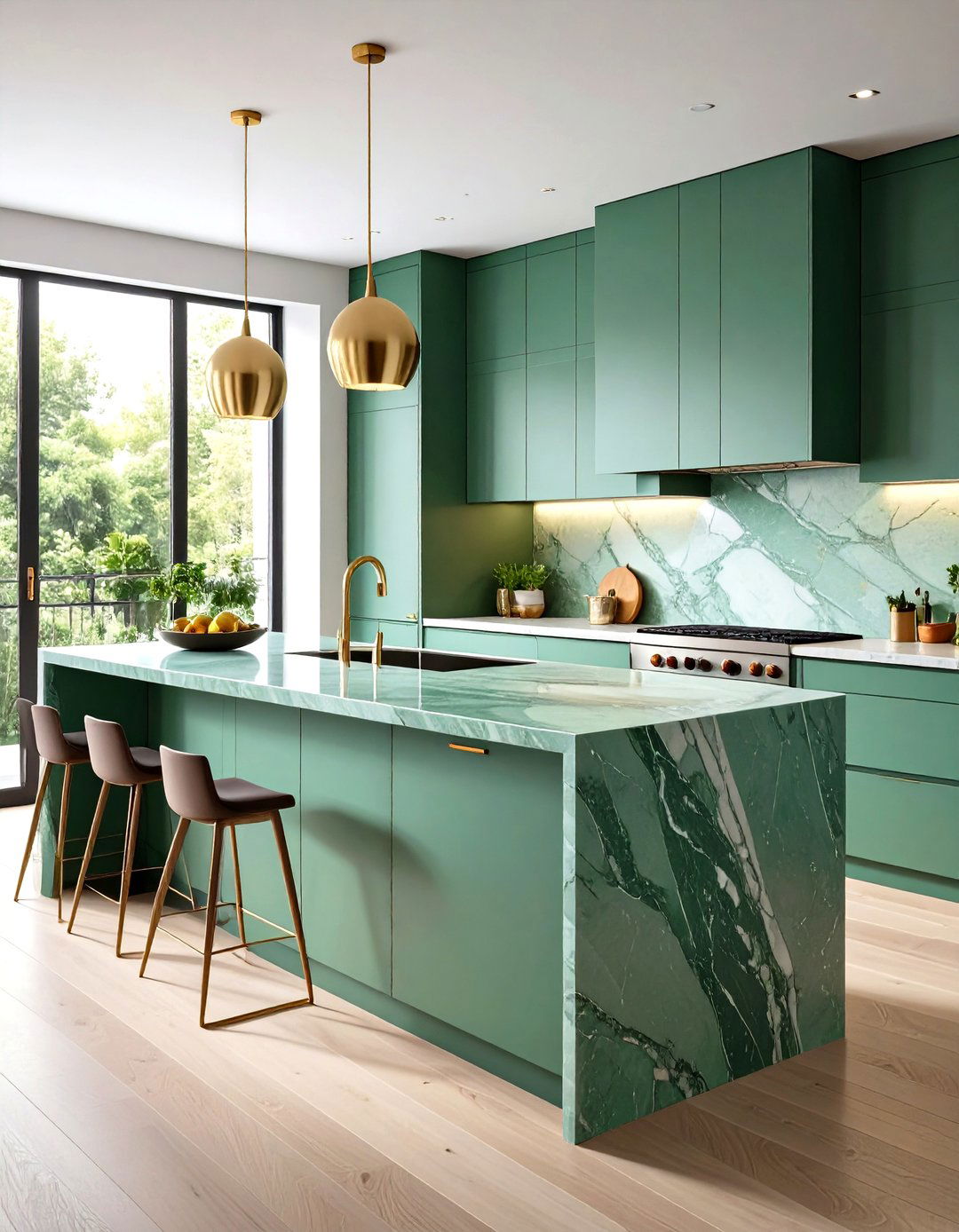
Architects pushing sleek minimalism are requesting green marble countertops as thin as 20 mm, delivering a “floating” impression atop handle-less cabinetry. To maintain structural integrity, professionals bond the marble to lightweight honeycomb aluminum backing—reducing weight while retaining stone beauty. The svelte edge visually enlarges small galley kitchens and blends seamlessly with contemporary appliances. Because thin cuts can chip, specify a gently chamfered edge rather than a razor-sharp mitre. Finish with a suede texture to hide everyday wear. Strategic under-counter supports and correct adhesive are non-negotiable for longevity, ensuring the statement surface remains both ethereal and enduring. Creative Granite & Design
12. Integrated Sink Carved from One Slab
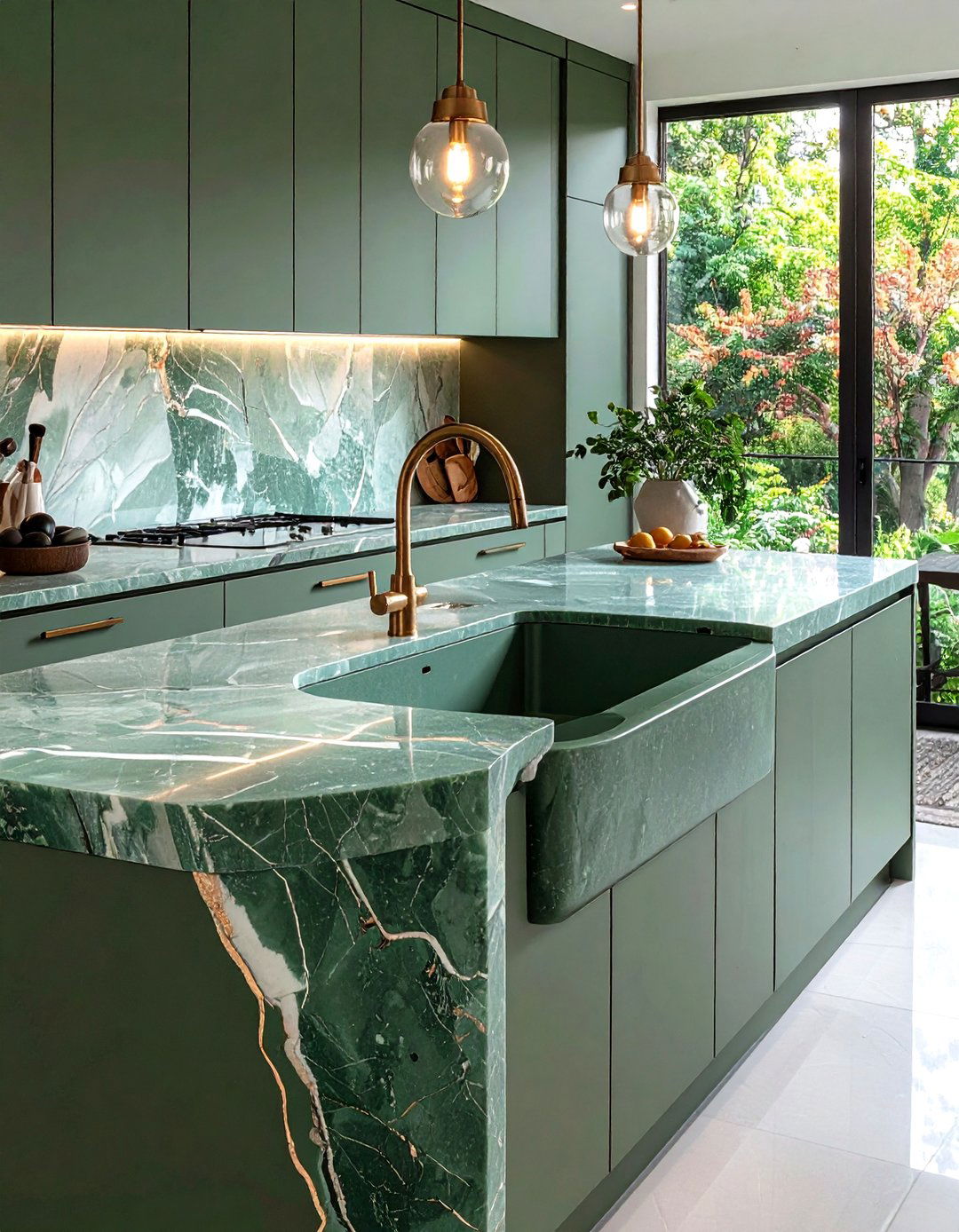
Carving sink basins directly from the same green marble slab yields a monolithic look that collectors love. Remodelista showcases kitchens where the counter slopes into a seamless trough, eliminating silicon seams that trap grime. Precision CNC machining creates crisp lines, followed by hand-sanding to soften curves. Integrated drainboards keep water marks contained. Ensure the fabricator reinforces the underside with steel rods; basin weight can stress the stone. Finish the sink interior with an extra layer of sealer because standing water accelerates etching. The payoff is a showpiece marrying sculptural artistry and daily function in a single uninterrupted surface. Remodelista Pinterest
13. Two-Tone Island Top for Visual Zoning
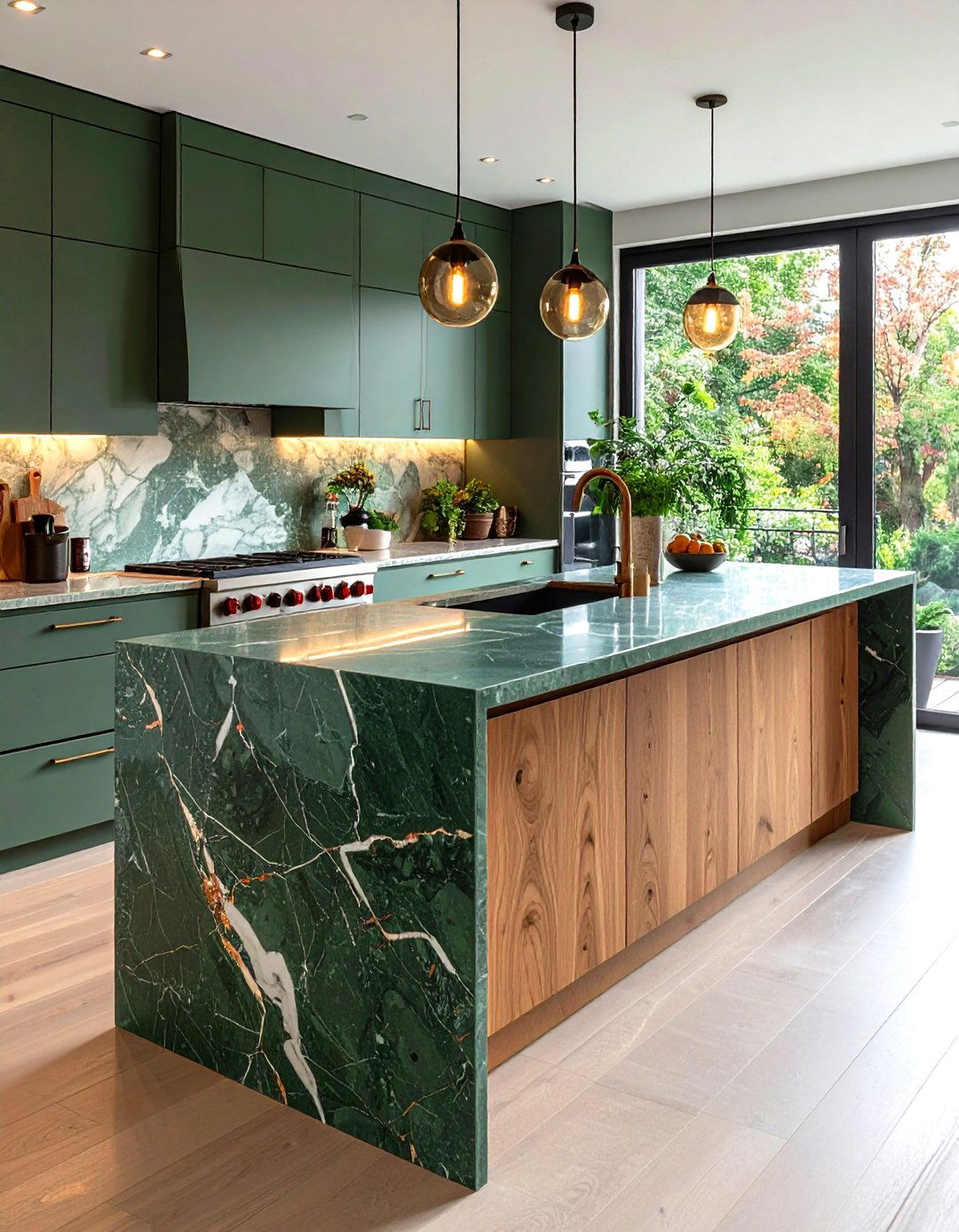
Designers are splitting large islands into two surfaces—wood butcher block for chopping and dramatic green marble countertop for pastry or cocktail prep. This two-tone strategy saves on stone cost while zoning tasks. Place the marble nearest plumbing lines to handle wet work; reserve timber for cut-friendly areas. Match the marble’s accent colors in cabinet kicks or pendant shades for cohesion. Industry trend lists predict contrasting countertops will continue rising because they add depth without clutter. Be mindful of height transitions: recess the wood 3 mm below the stone, making a practical crumb-catcher and soft edge for elbows. Homes & Gardens
14. Art-Deco Bar with Emerald Inlay
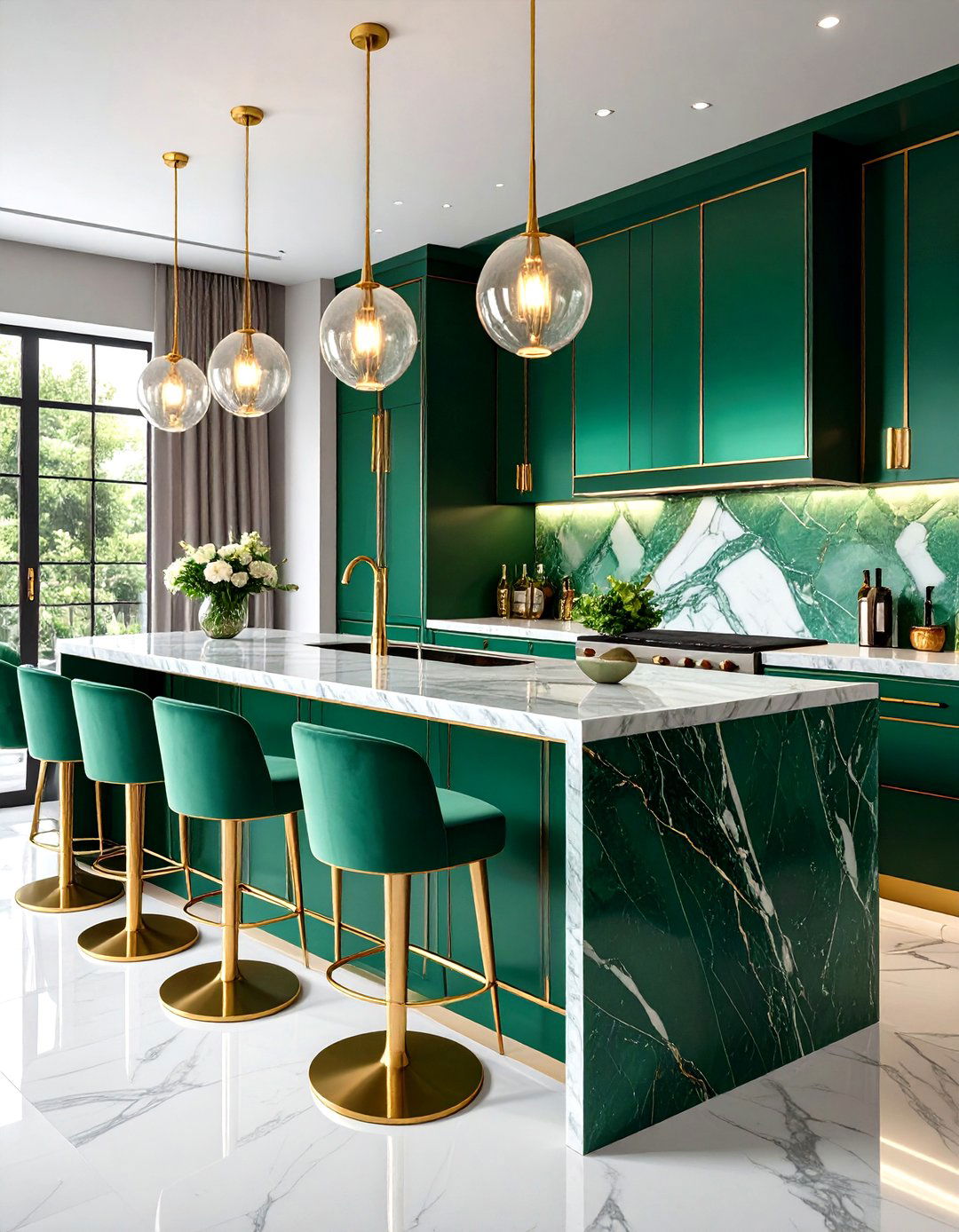
If entertaining tops your agenda, craft an art-deco home bar crowned by emerald green marble countertops edged in slim brass inlay. The stone’s jewel-tone richness evokes vintage cocktail lounges, while geometric brass strips reference 1920s glamour. Keep front panels high-gloss lacquer in midnight blue or jet black for contrast. A subtle ogee edge, trending again per design forecasts, offers period authenticity. Seal the marble thoroughly—citrus garnishes etch quickly—but the visual rewards outweigh the vigilance. Dimable sconces washing down the backsplash make veins shimmer like malachite, ensuring your bar area steals spotlight long after the last toast. Homes & Gardens H Century Star
15. Suede-Finish Vanity for Spa Calm
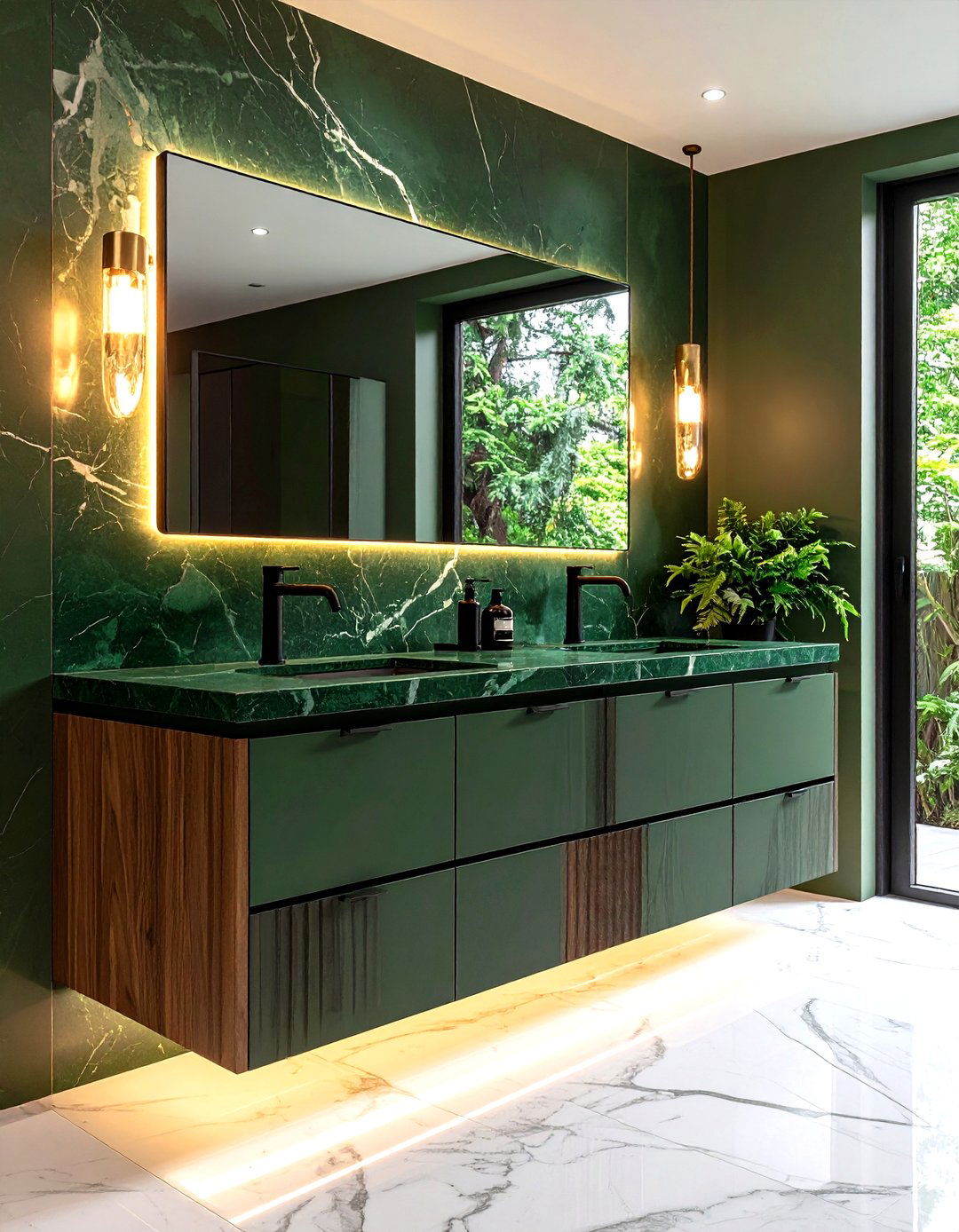
In bathrooms, a suede-finish green marble countertop provides tactile luxury and reduces glare from vanity lights. Texture-oriented trend reports highlight leathered or brushed stones for hiding water droplets—a boon around faucets. Pair the countertop with fluted-oak drawers and matte-black taps to modernize the spa vibe. Because bathrooms experience high humidity, select a penetrating sealer rated for wet zones and reapply annually. Position LED mirrors slightly forward to graze the stone, accentuating its velvety surface. Even compact powder rooms gain depth as the marble’s muted sheen contrasts crisp porcelain and plush towels, making everyday routines feel indulgent. Creative Granite & Design
16. Semi-Floating Peninsula Breakfast Bar
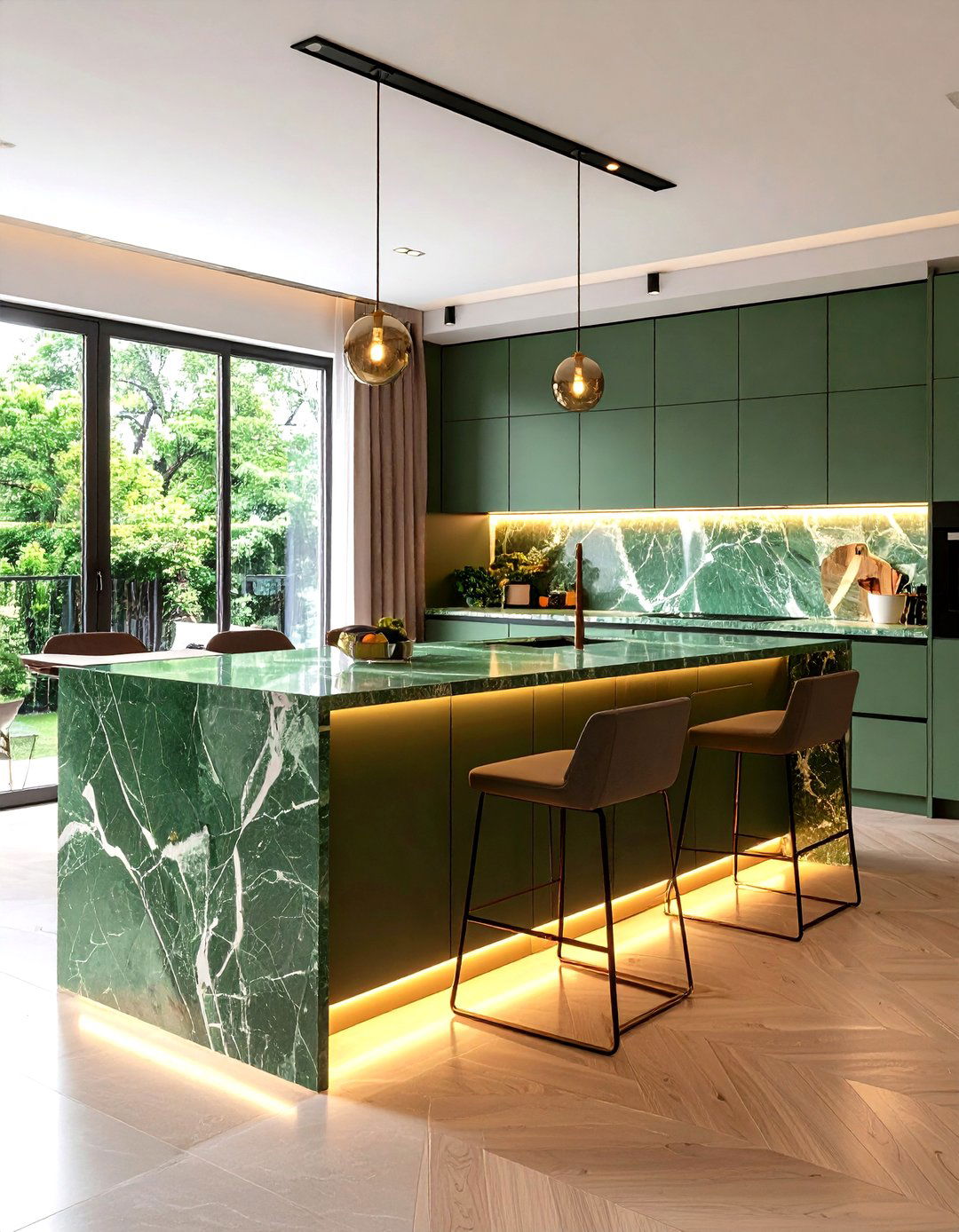
For open-plan apartments, a green marble countertop cantilevered 25–30 cm from base cabinets creates a slim breakfast perch without bulky legs. Structural steel brackets hidden inside drywall provide support, yielding a light, airy silhouette. Choose a marble with dramatic diagonal veining to direct gaze into the living area, visually elongating the room. Install warm strip lighting beneath the overhang to highlight translucence and act as nightlight. Designers caution to keep seating lightweight so the overhang isn’t overloaded; metal stools with slender profiles maintain the floating illusion. This layout doubles prep space by day and seamless dining by night. Natural Stone City Homes & Gardens
17. Accent Lighting to Showcase Veining
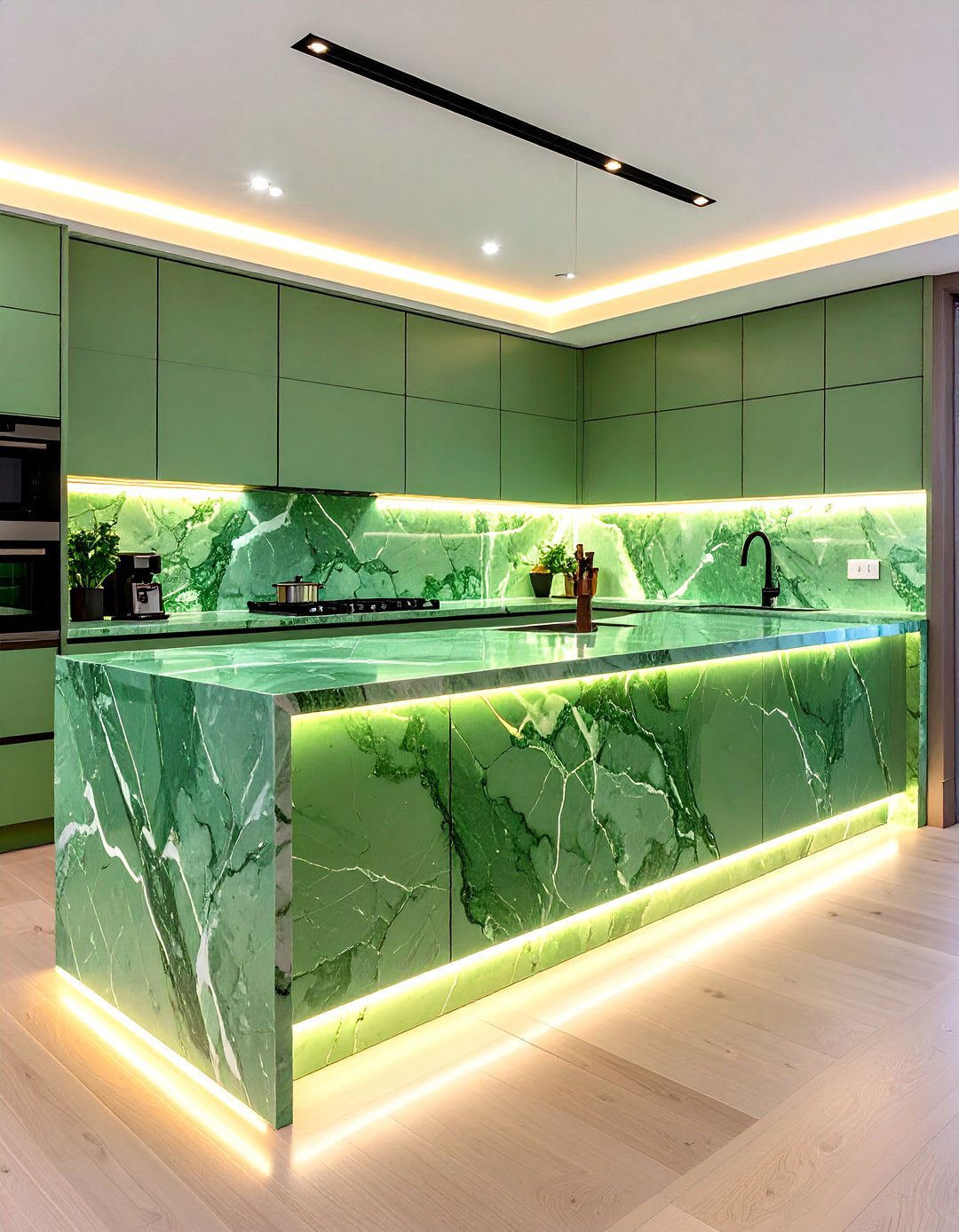
Targeted lighting can make a green marble countertop sparkle like polished gemstone. LED strip lights installed at the cabinet toe-kick cast upward glow, emphasizing veining complexity. Task pendants with adjustable Kelvin temperatures let homeowners warm the marble’s undertones for cozy dinners or cool them for crisp morning prep. Color consultants note that moody greens benefit from 2700-3000 K warm lighting to avoid looking murky. Keep fixtures dimmable to reduce glare on polished surfaces. Position outlets strategically so cords remain invisible; nothing ruins a luxurious stone like cluttered cables. Intelligent lighting turns the countertop into a living canvas that shifts with ambiance. Ideal Home
18. Geometric or Ogee Edges for Character
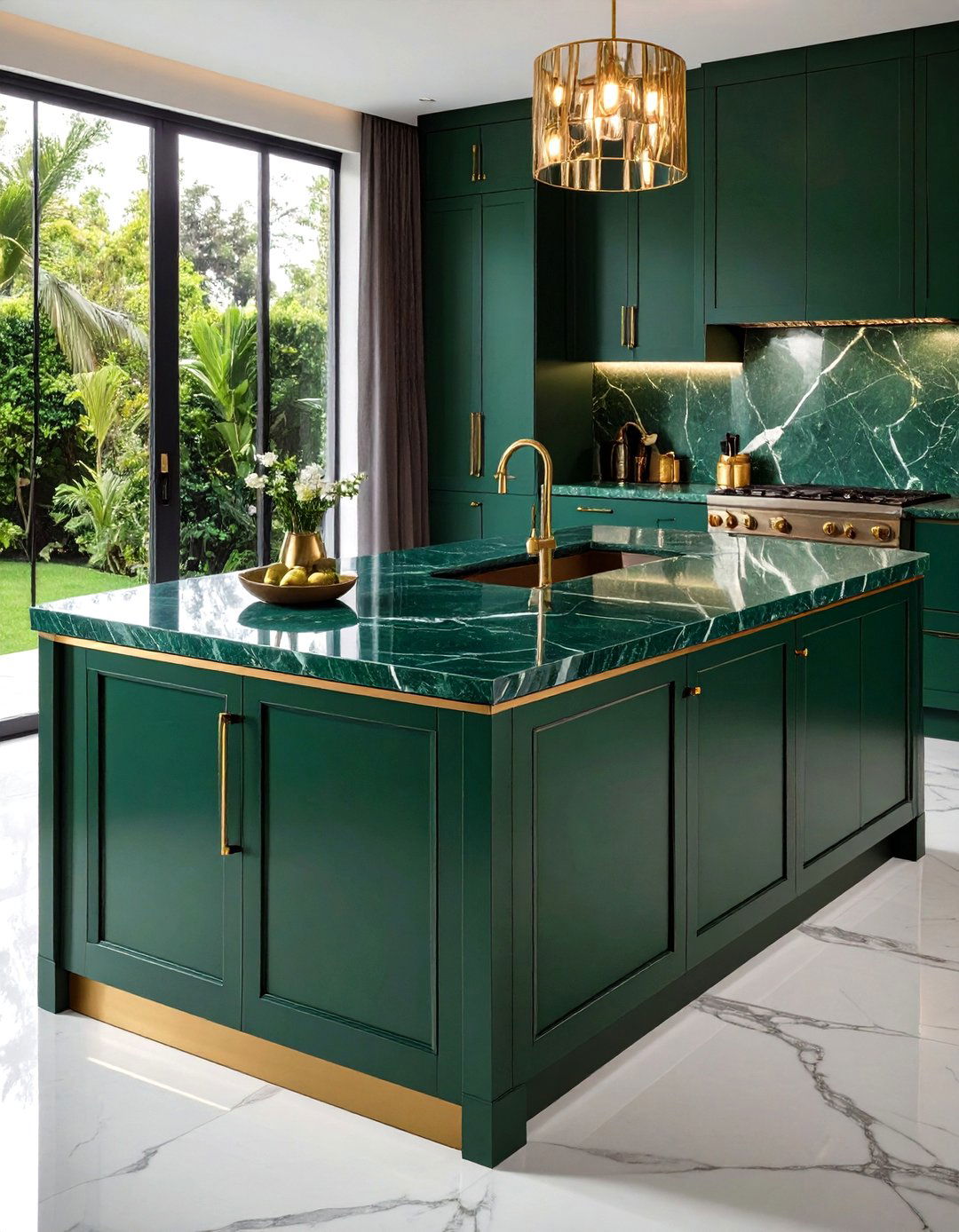
Detailed countertop edges are staging a comeback, according to 2025 trend roundups. Swapping the ubiquitous straight edge for a subtle ogee, beveled, or even chamfered profile on a green marble countertop introduces shadow play that accentuates thickness and craftsmanship. Choose edges proportionate to slab thickness—an exaggerated ogee on a thin profile can read faux. Edge detailing adds child-friendly softness and minimizes chipping on exposed corners. Discuss tooling radius with your fabricator; sharp points can break during transport. A precisely milled edge paired with a honed surface balances old-world elegance and contemporary restraint, giving green marble renewed personality. Homes & Gardens Cutting Edge Countertops
19. Full-Height Slab Backsplash Continuation
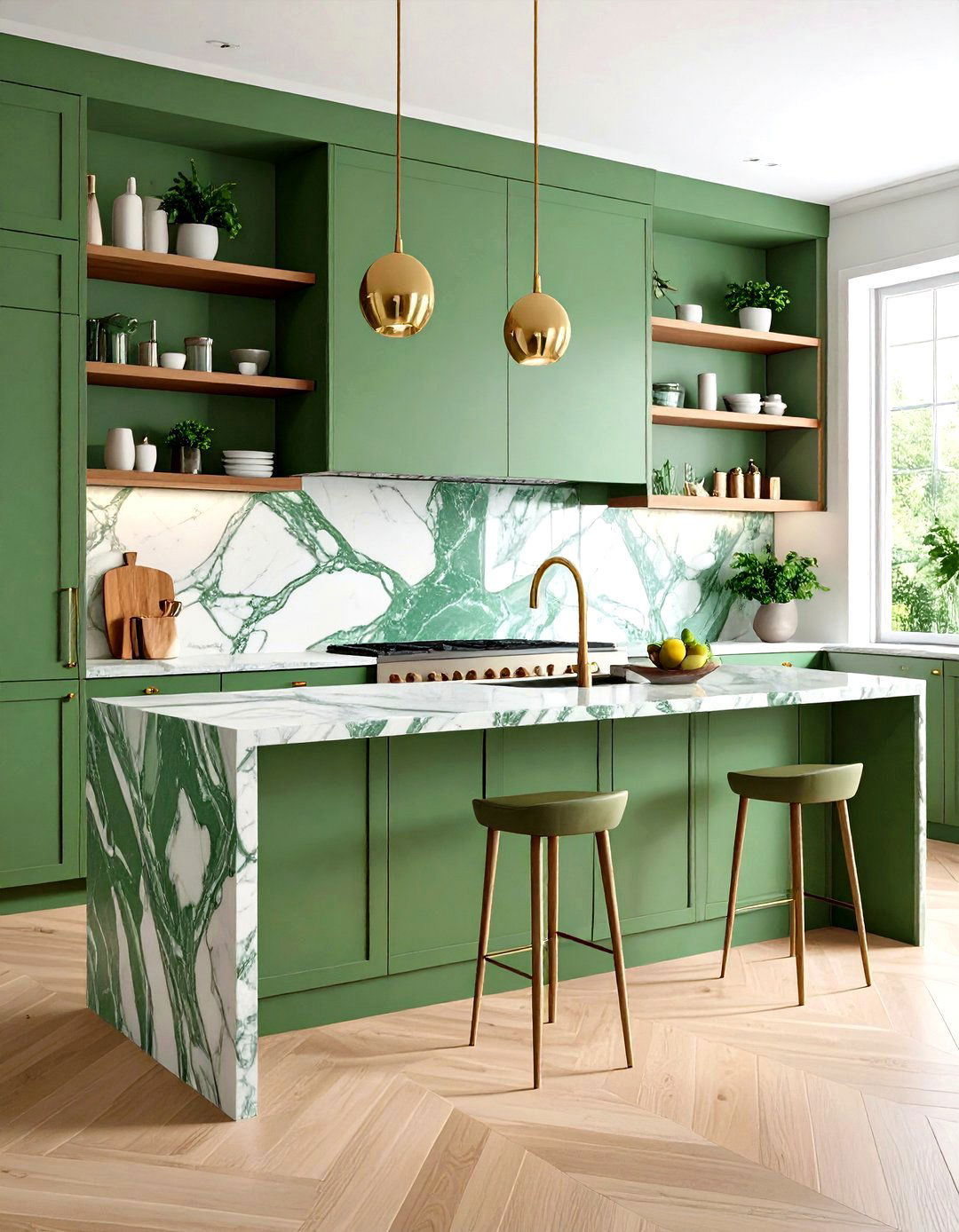
Extending your green marble countertop straight up the wall creates a seamless backsplash that eliminates messy grout lines and magnifies the stone’s pattern. High-contrast veining becomes an art feature, especially behind open shelving that frames the slab like a gallery piece. Designers emphasize measuring ceiling heights early; taller walls may require book-matching or stacking slabs, so plan vein alignment. Install floating ledges in walnut or black metal to display neutral ceramics that won’t compete with the marble. A continuous slab also speeds cleanup—grease splatters wipe off without staining grout. This cohesive sweep of green turns everyday cooking into an immersive design experience. Natural Stone City Cornerstone House
20. Budget-Friendly Tile Counter with Contrasting Grout
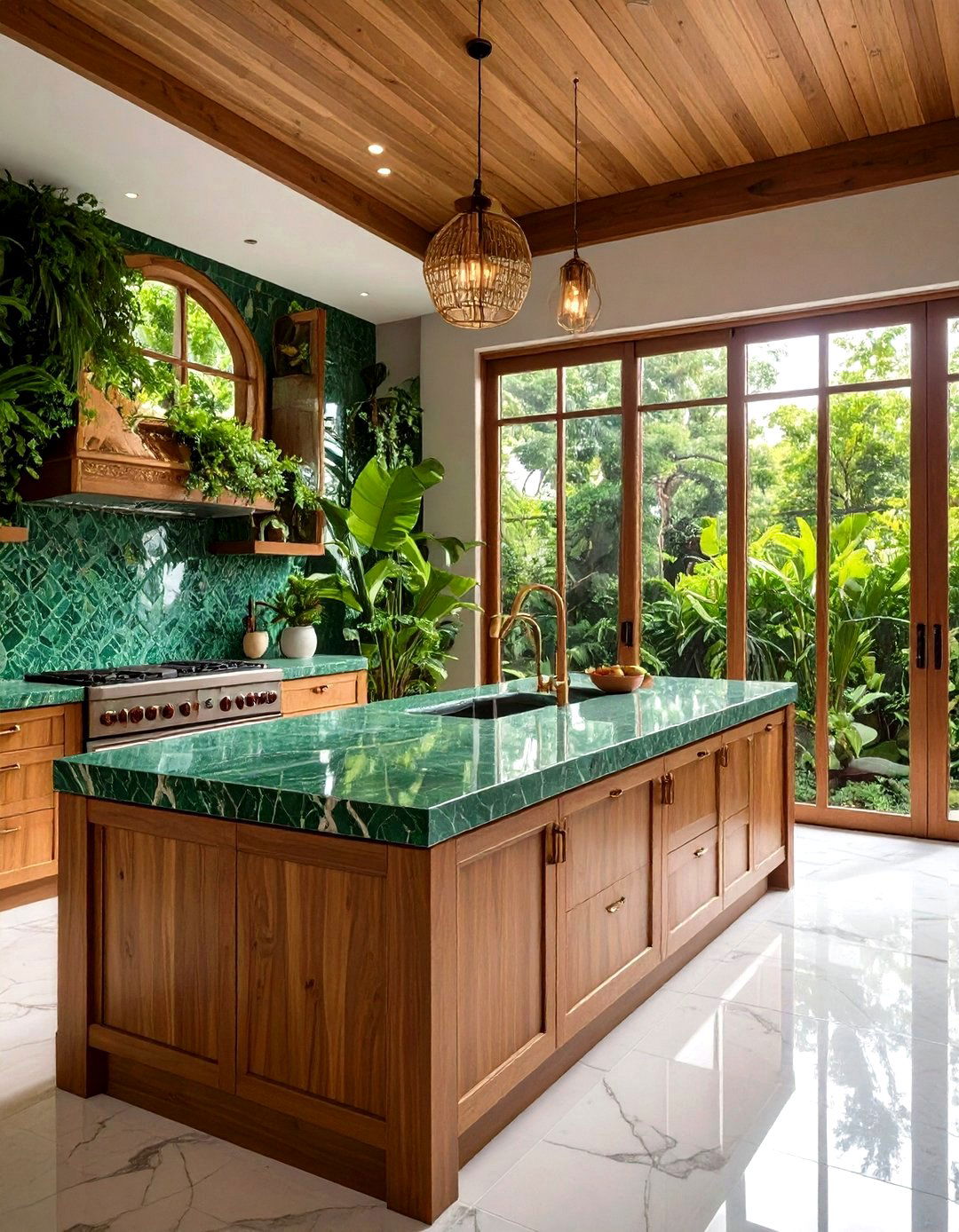
Those seeking green marble’s allure on a thriftier budget can lay small-format marble tiles on a plywood sub-top, finishing with epoxy grout in a contrasting beige or charcoal. Tile suppliers offer pre-sealed mosaics in shades like Ming Green; the varied pattern ticks today’s “movement” trend boxes. Use narrow 2 mm joints to keep maintenance low and mimic slab aesthetics. Edge the countertop with a solid-wood border stained to match cabinets, protecting tile corners. Though grout needs occasional refreshing, individual tiles are easy to swap if damaged—an advantage over monolithic slabs. This approach delivers artisanal charm without overwhelming renovation budgets. Homes & Gardens
Conclusion:
Green marble countertops usher depth, drama, and serenity into modern interiors, whether expressed in monumental waterfall islands, textured suede vanities, or sustainable remnant mosaics. Pairing the stone with brass, oak, or clever lighting amplifies its natural beauty, while finishes like honing and leathering improve everyday practicality. By minding sealers, edge profiles, and smart support systems, homeowners can enjoy these vibrant surfaces—indoors or out—for decades, transforming kitchens and baths into timeless, nature-inspired sanctuaries. Natural Stone City


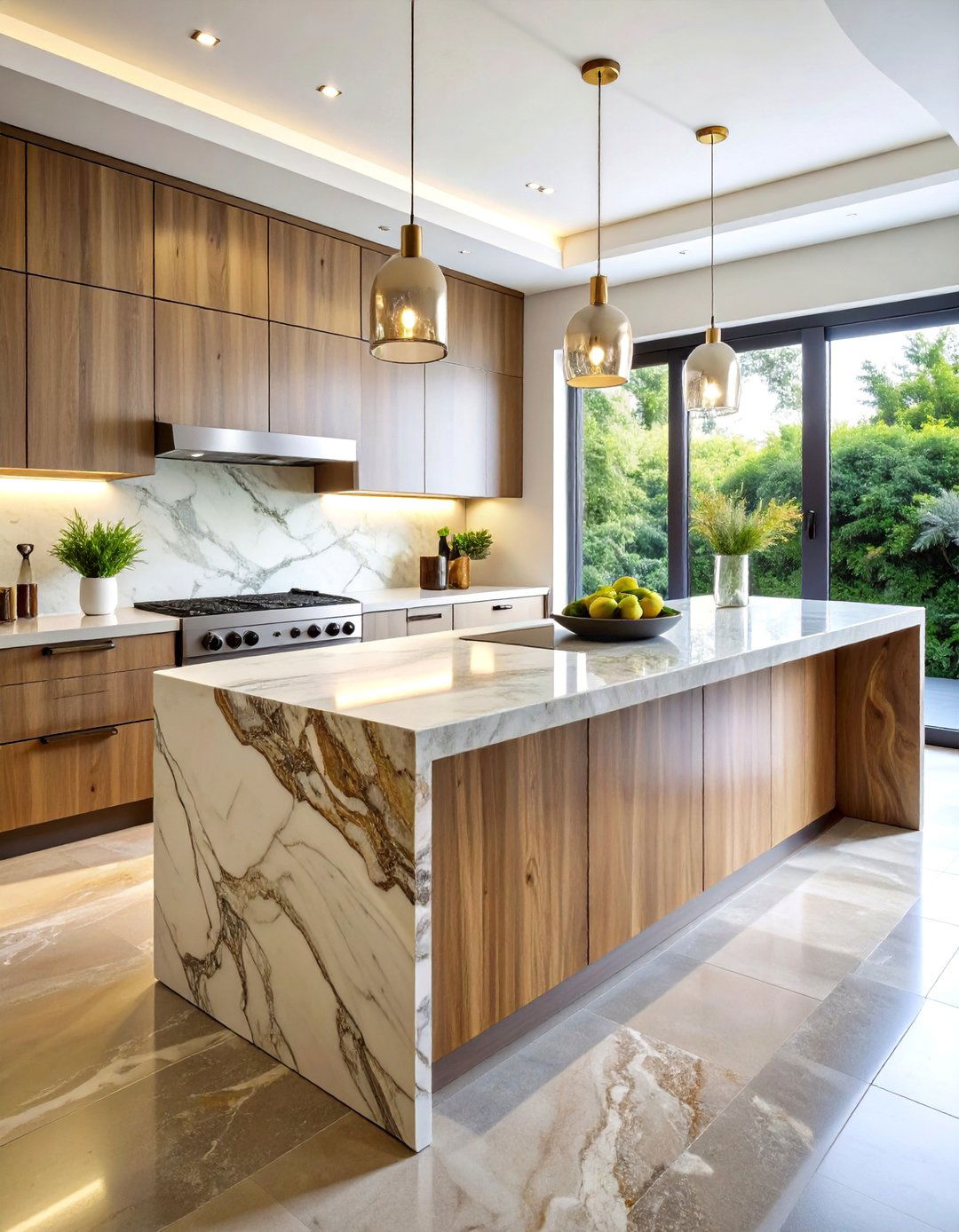
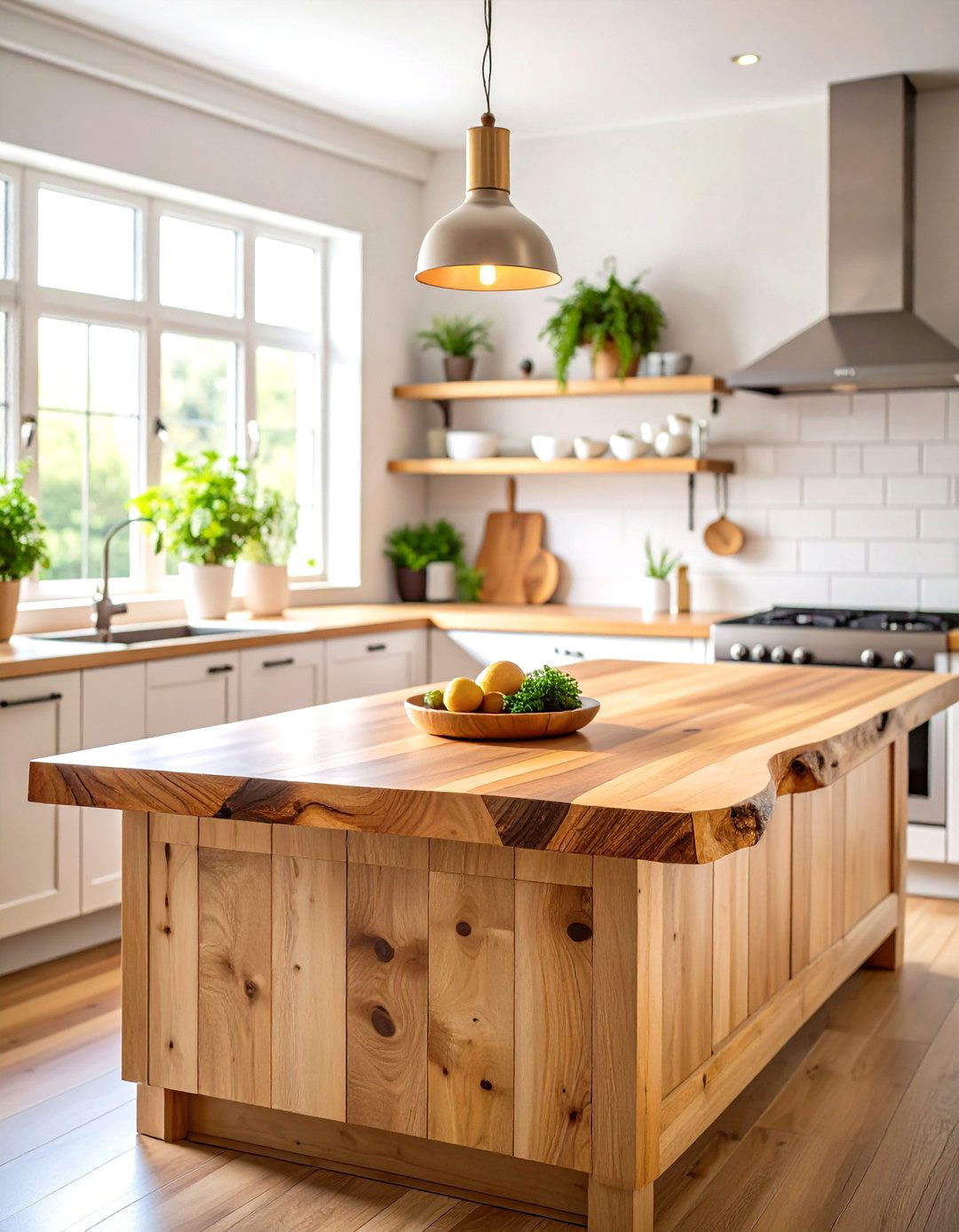
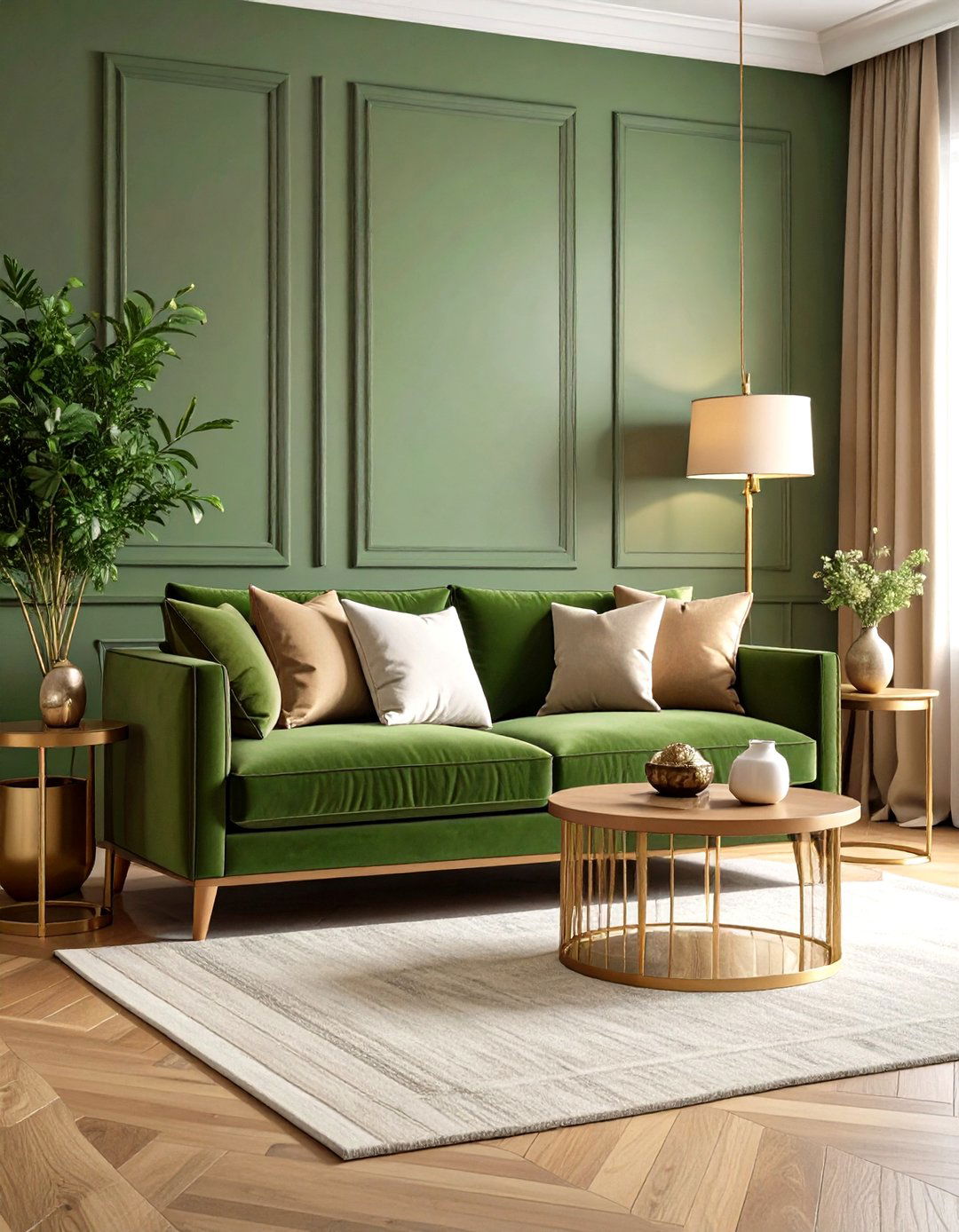
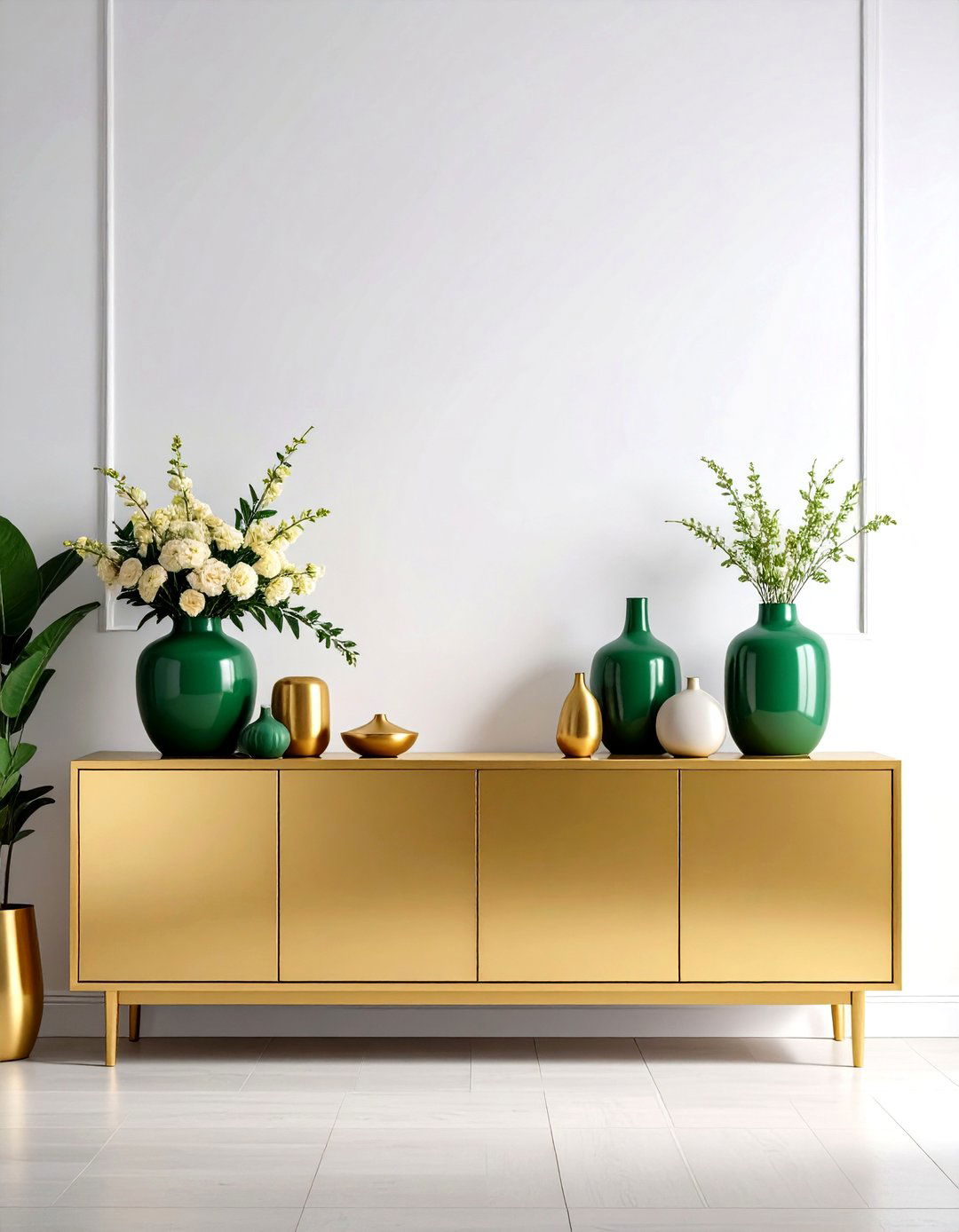
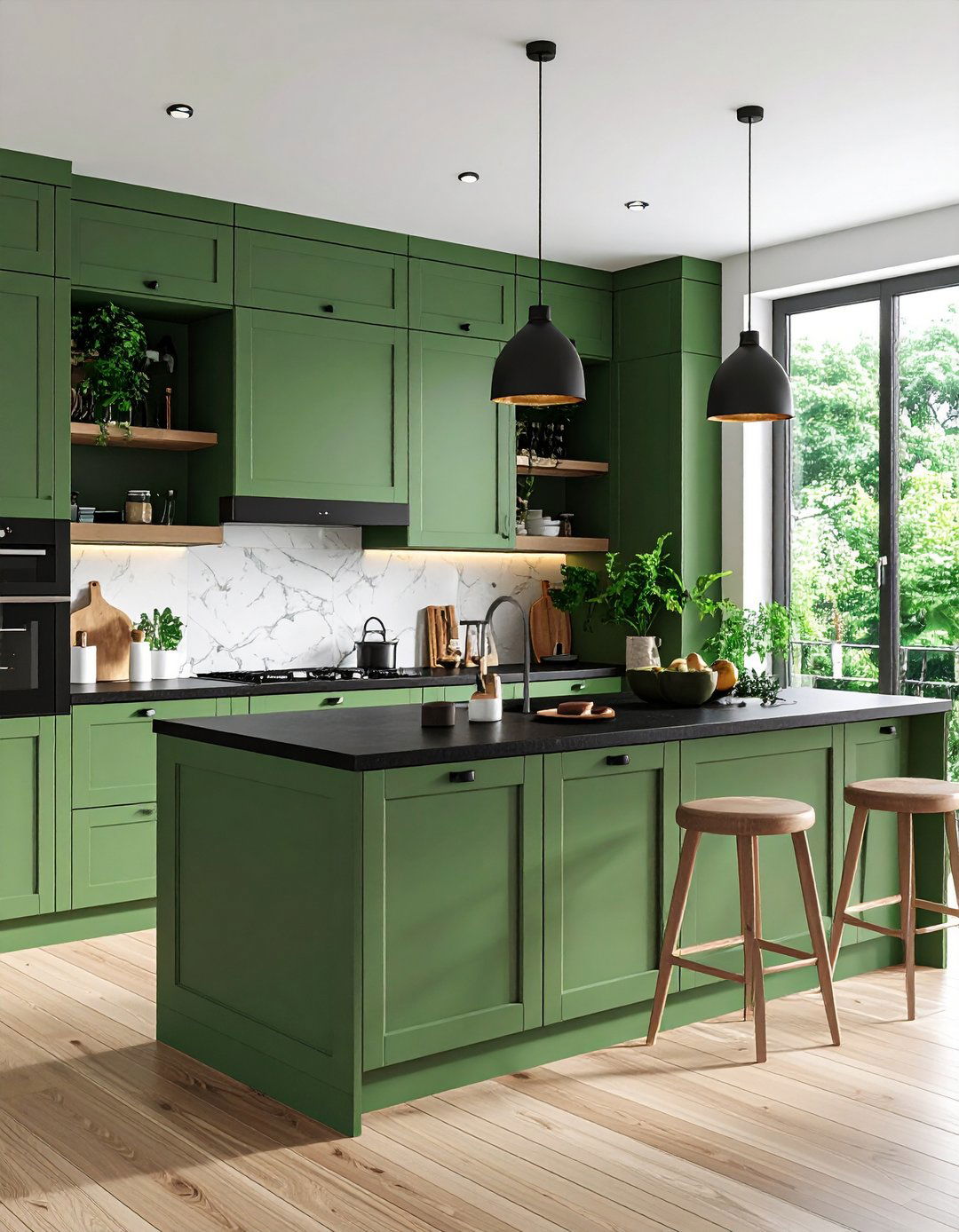
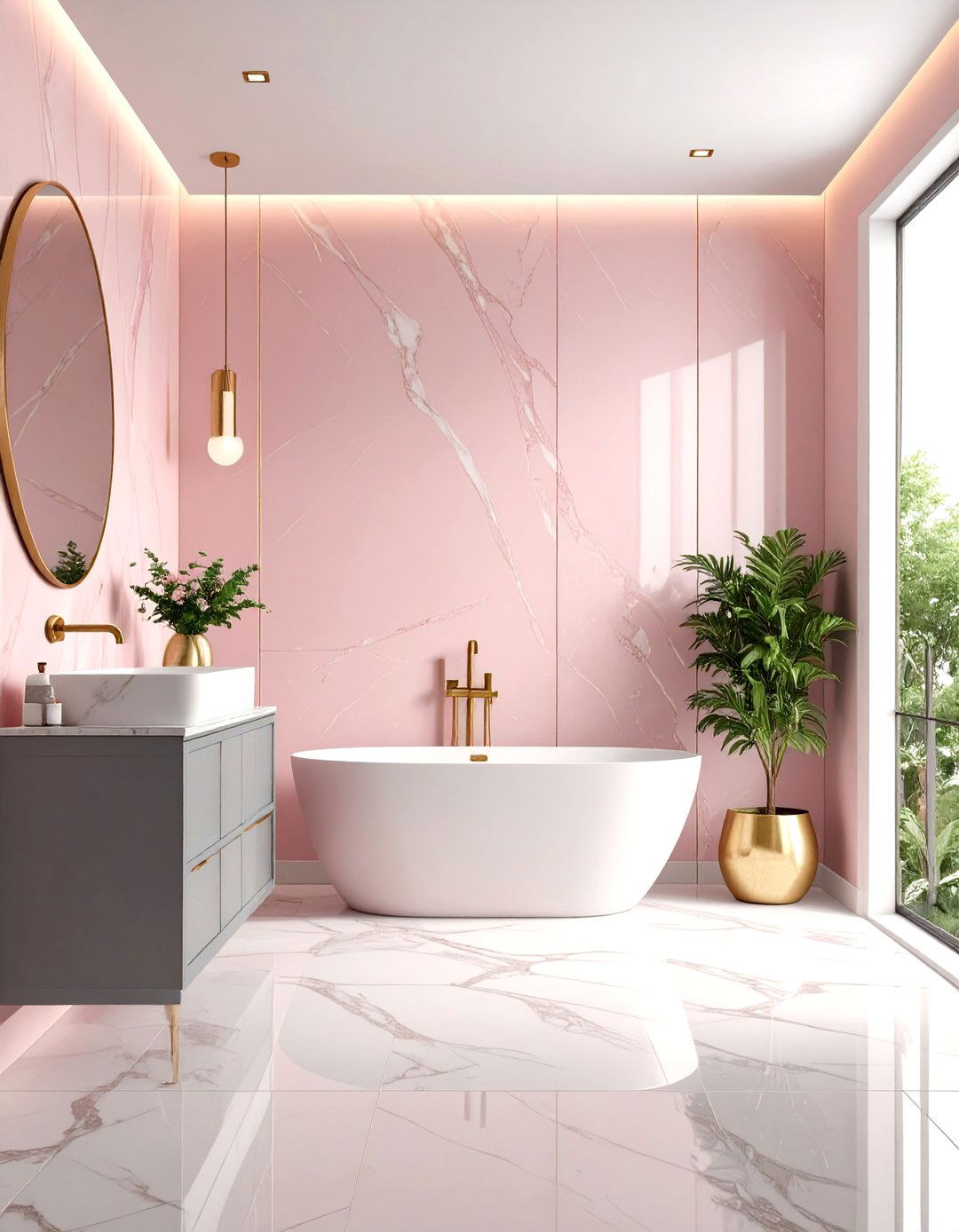
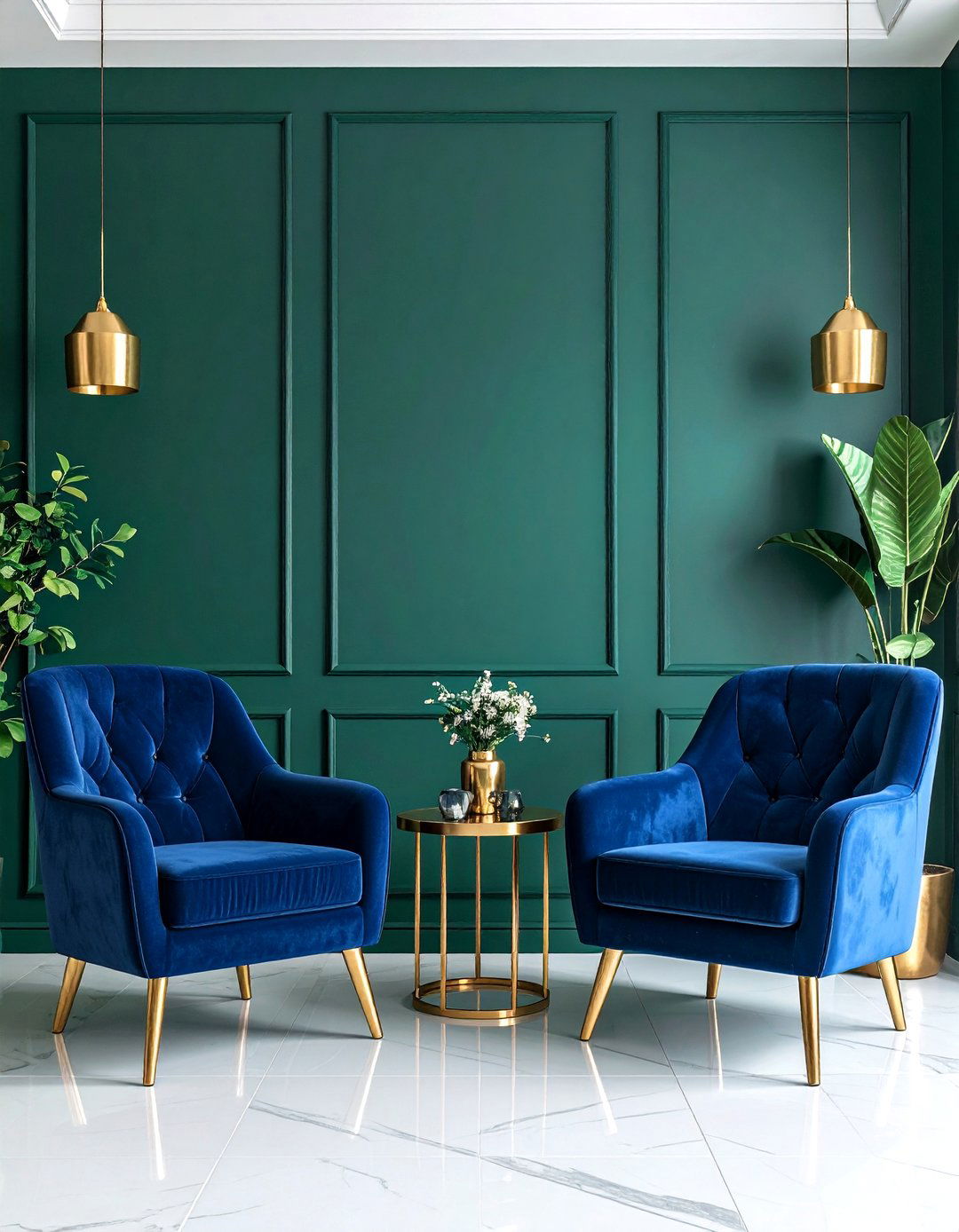
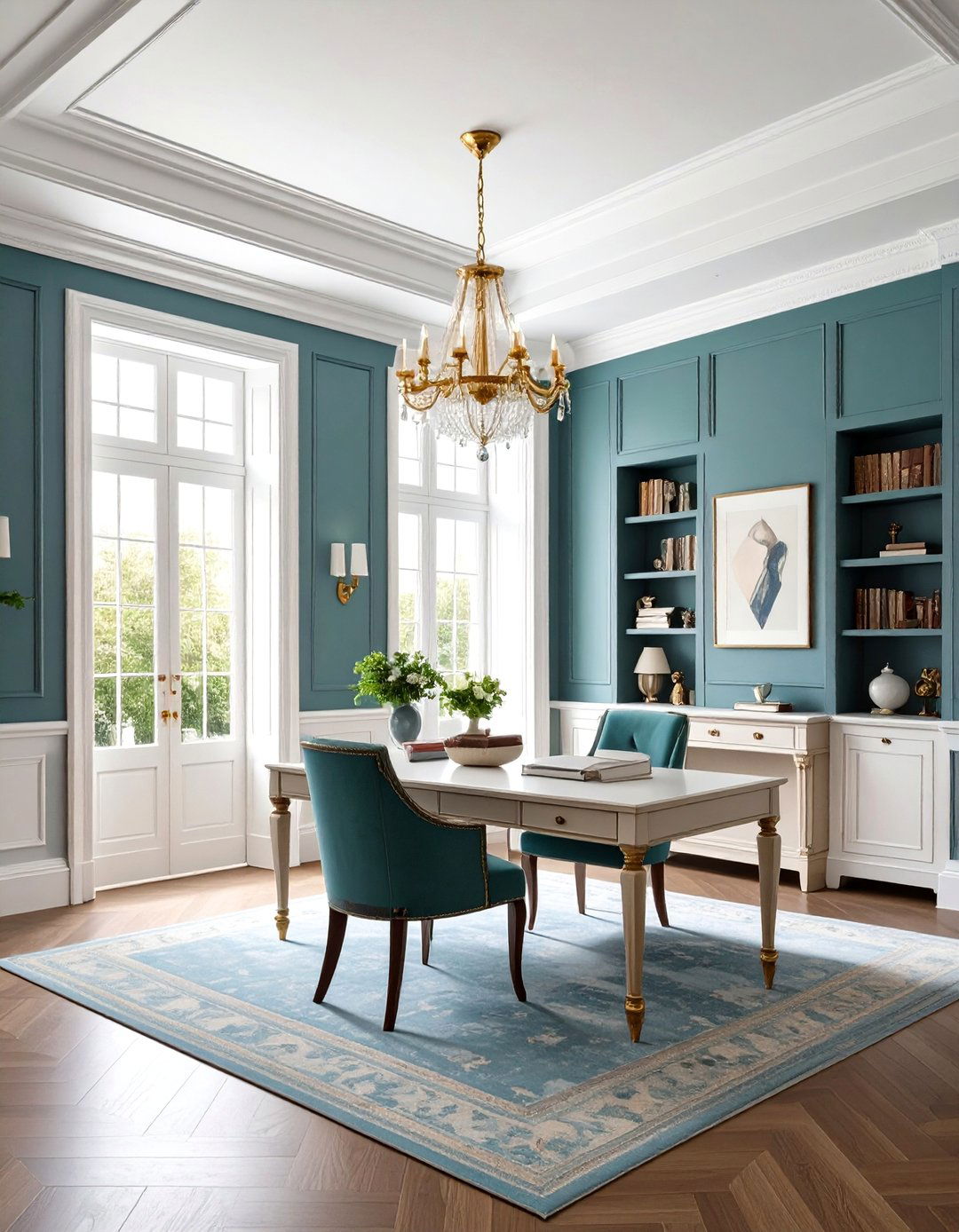
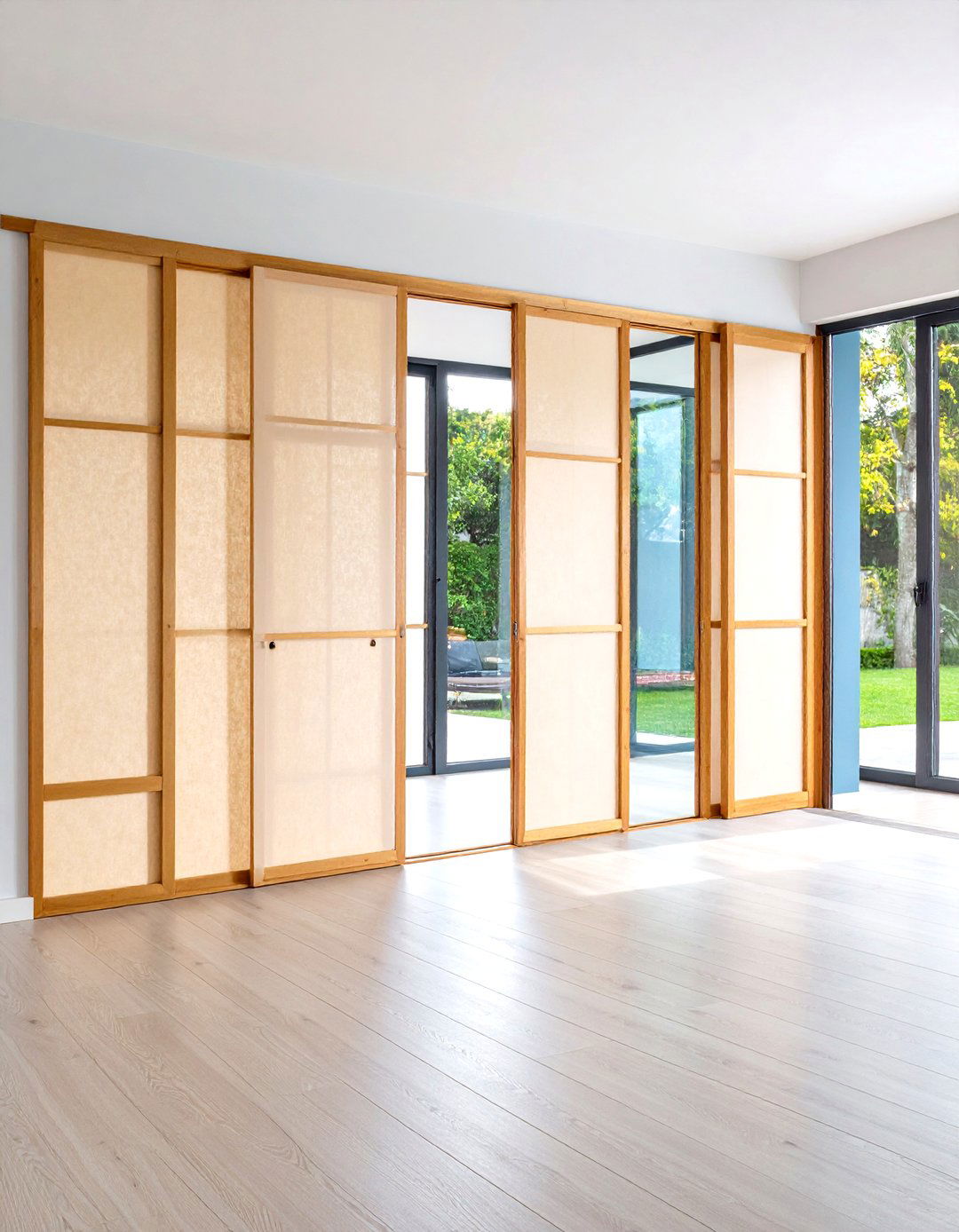
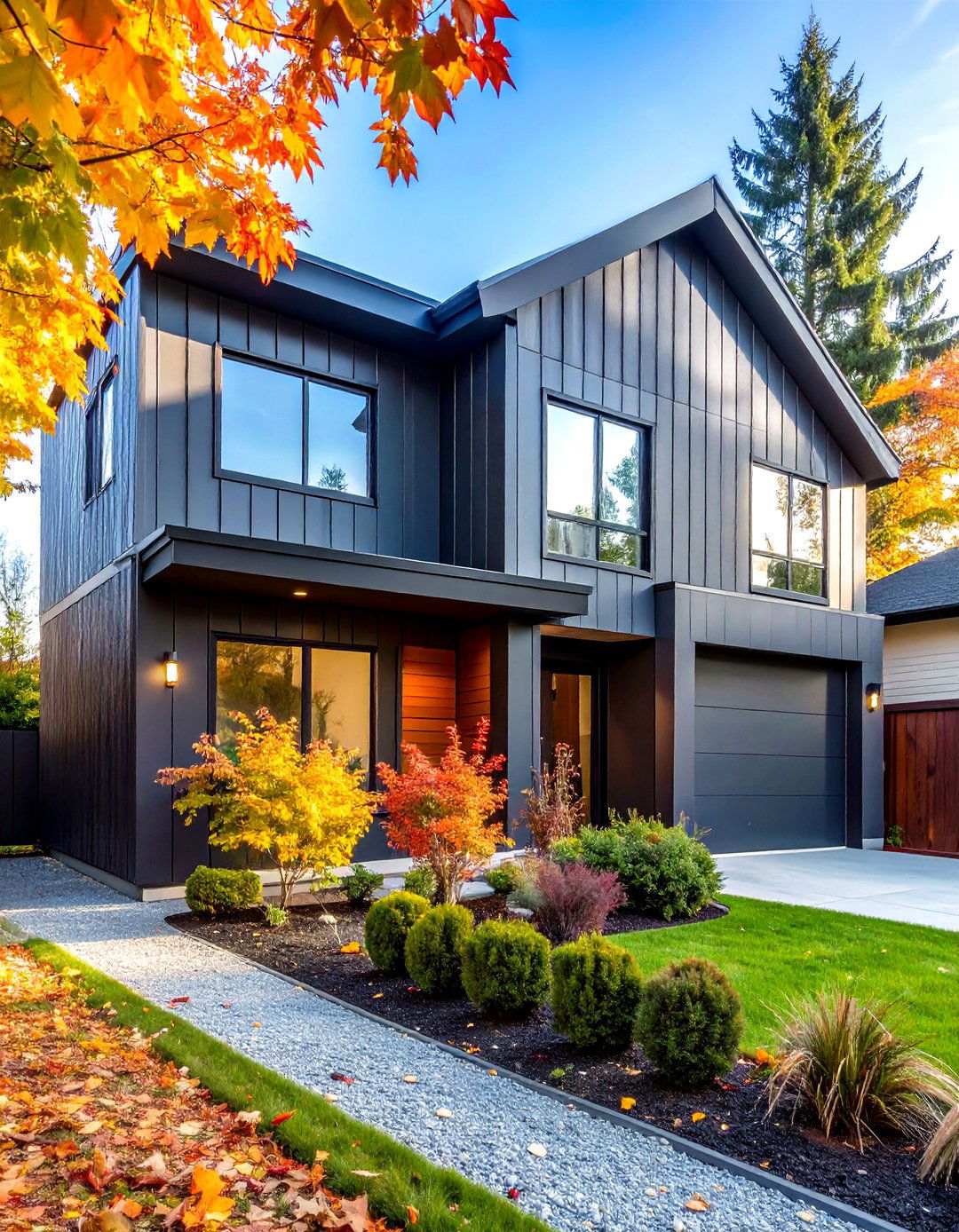
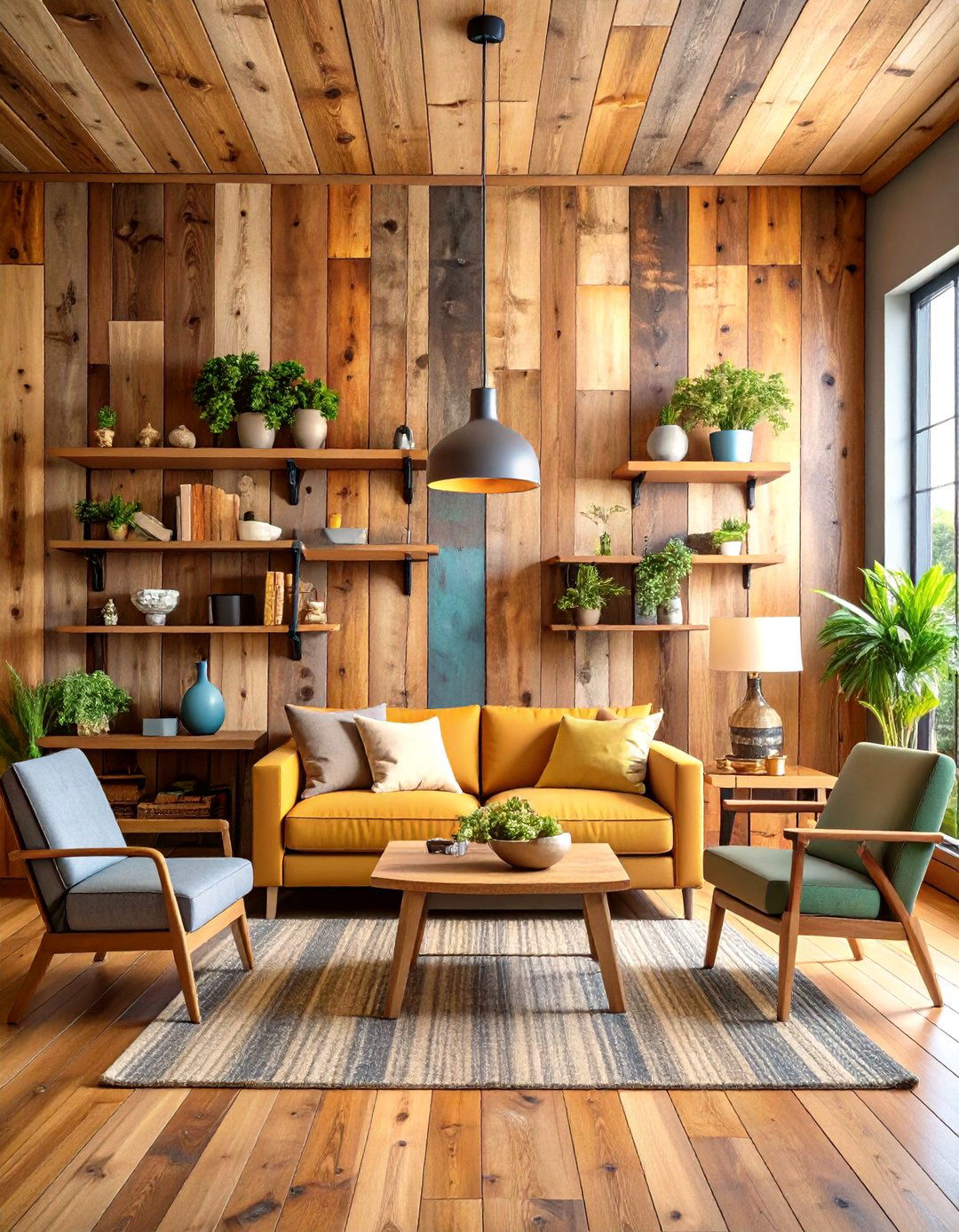
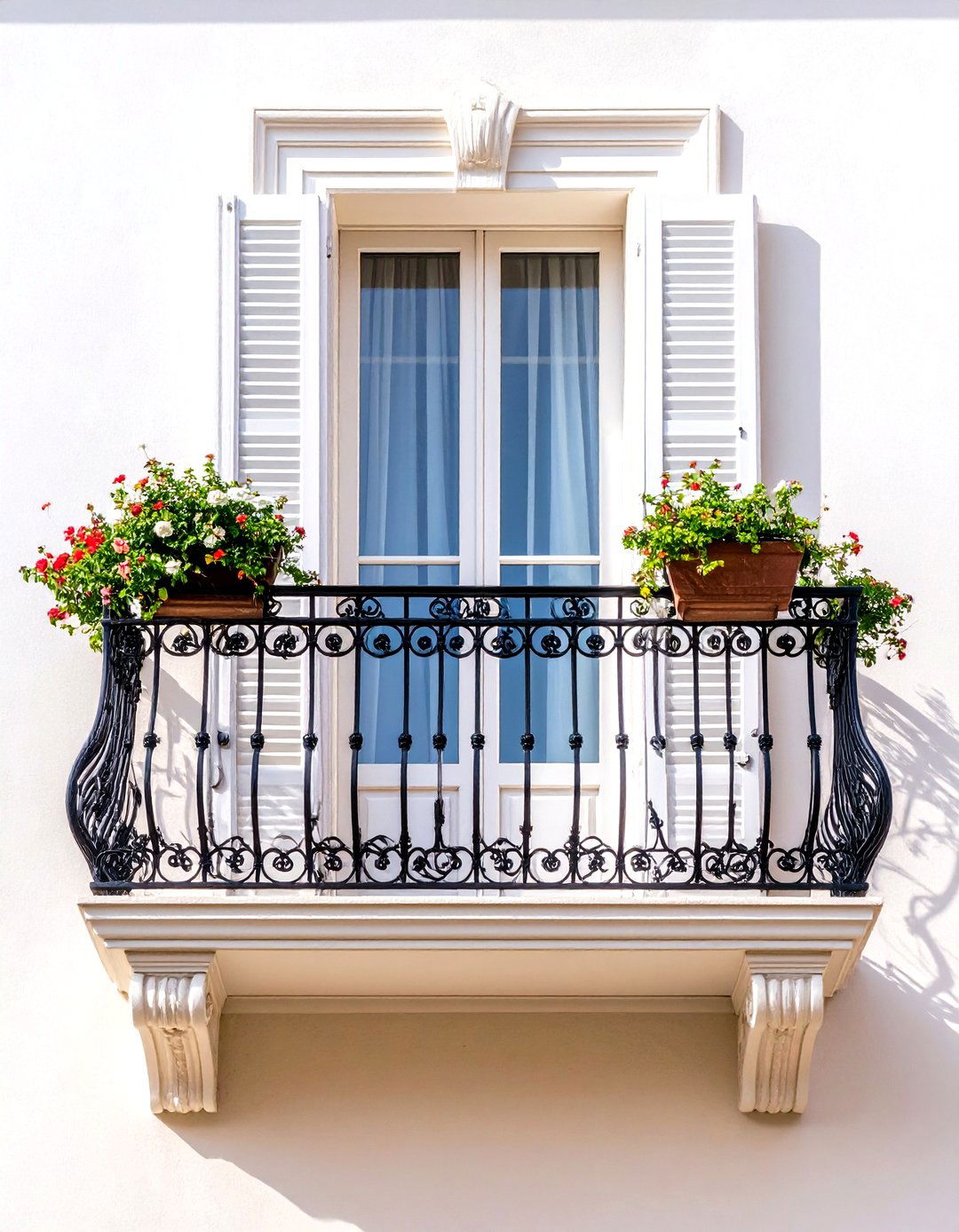
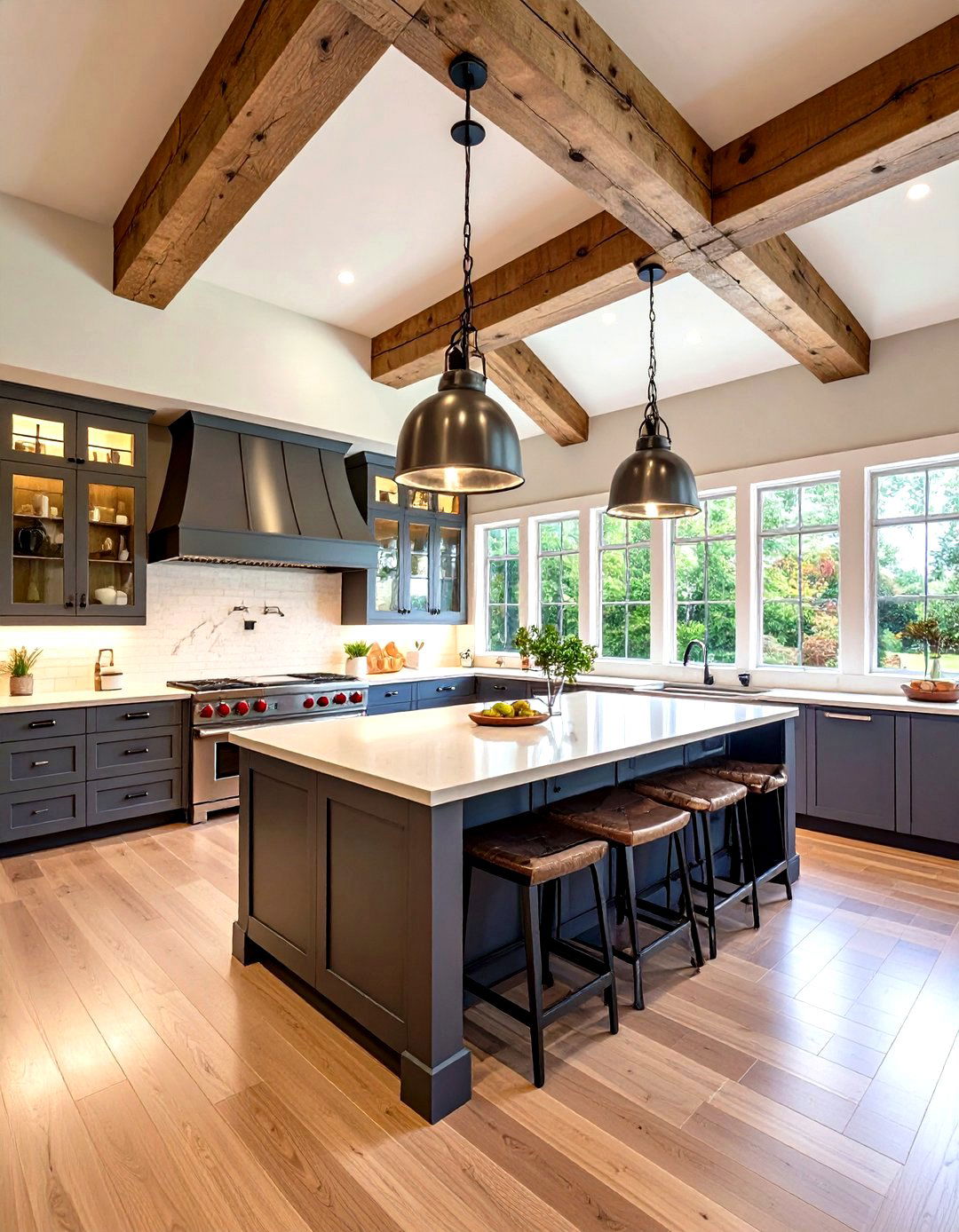
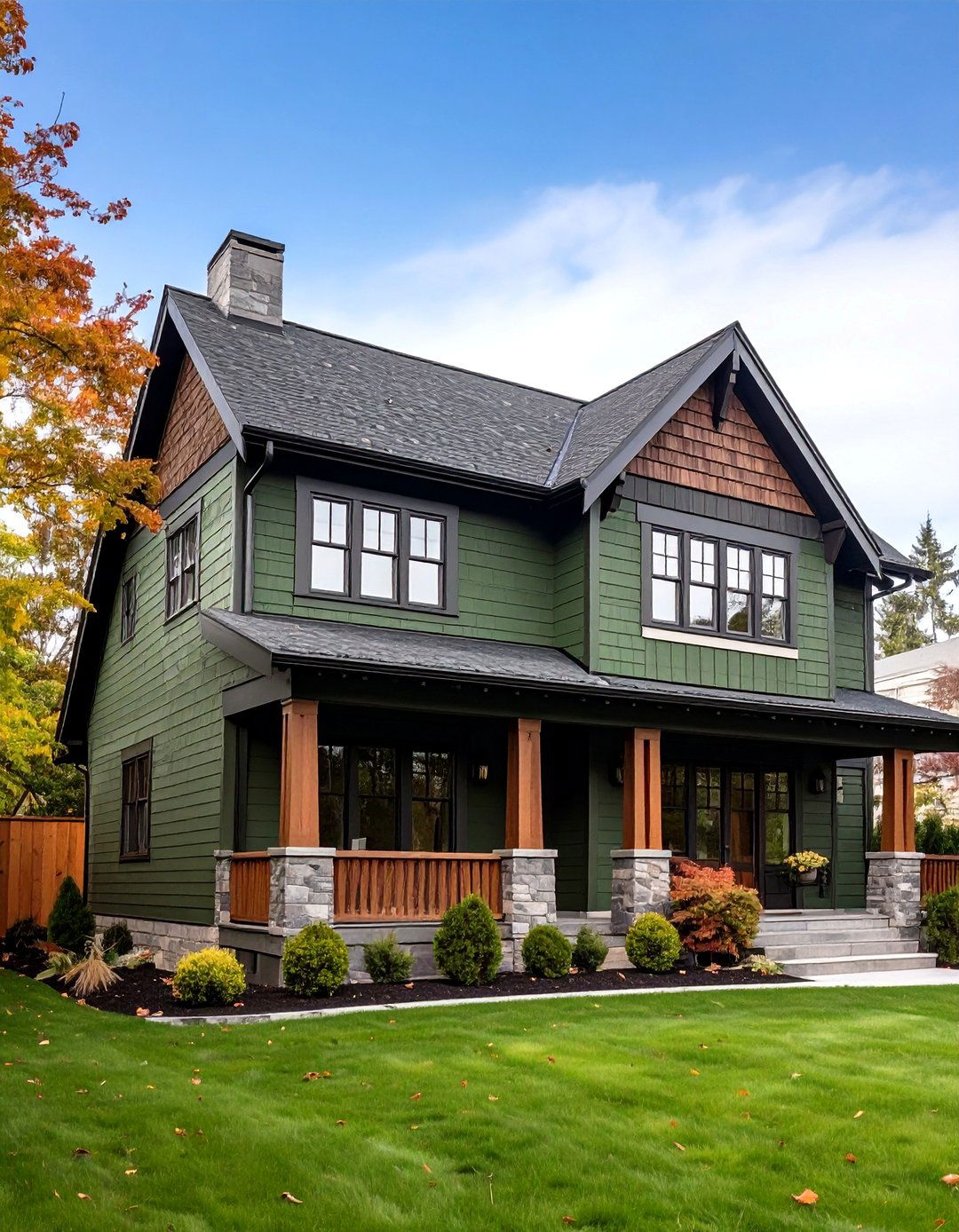
Leave a Reply